4.10 Cellular Respiration
Created by: CK-12/Adapted by Christine Miller

Bring on the S’mores!
This inviting camp fire can be used for both heat and light. Heat and light are two forms of energy that are released when a fuel like wood is burned. The cells of living things also get energy by “burning.” They “burn” glucose in a process called cellular respiration.
What Is Cellular Respiration?
Cellular respiration is the process by which living cells break down glucose molecules and release energy. The process is similar to burning, although it doesn’t produce light or intense heat as a campfire does. This is because cellular respiration releases the energy in glucose slowly and in many small steps. It uses the energy released to form molecules of ATP, the energy-carrying molecules that cells use to power biochemical processes. In this way, cellular respiration is an example of energy coupling: glucose is broken down in an exothermic reaction, and then the energy from this reaction powers the endothermic reaction of the formation of ATP. Cellular respiration involves many chemical reactions, but they can all be summed up with this chemical equation:
C6H12O6 6O2 → 6CO2 6H2O Chemical Energy (in ATP)
In words, the equation shows that glucose (C6H12O6) and oxygen (O2) react to form carbon dioxide (CO2) and water (H2O), releasing energy in the process. Because oxygen is required for cellular respiration, it is an aerobic process.
Cellular respiration occurs in the cells of all living things, both autotrophs and heterotrophs. All of them burn glucose to form ATP. The reactions of cellular respiration can be grouped into three stages: glycolysis, the citric acid cycle (also called the Kreb’s cycle), and electron transport. Figure 4.10.2 gives an overview of these three stages, which are also described in detail below.
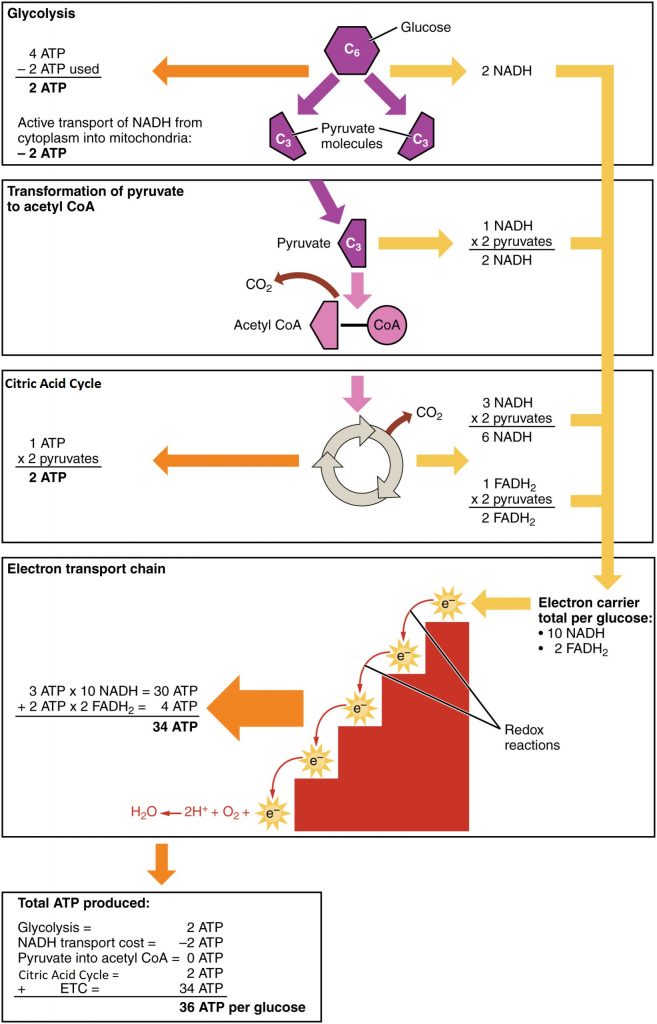
Cellular Respiration Stage I: Glycolysis
The first stage of cellular respiration is glycolysis, which happens in the cytosol of the cytoplasm.
Splitting Glucose
The word glycolysis literally means “glucose splitting,” which is exactly what happens in this stage. Enzymes split a molecule of glucose into two molecules of pyruvate (also known as pyruvic acid). This occurs in several steps; the result is summarized in the following diagram.
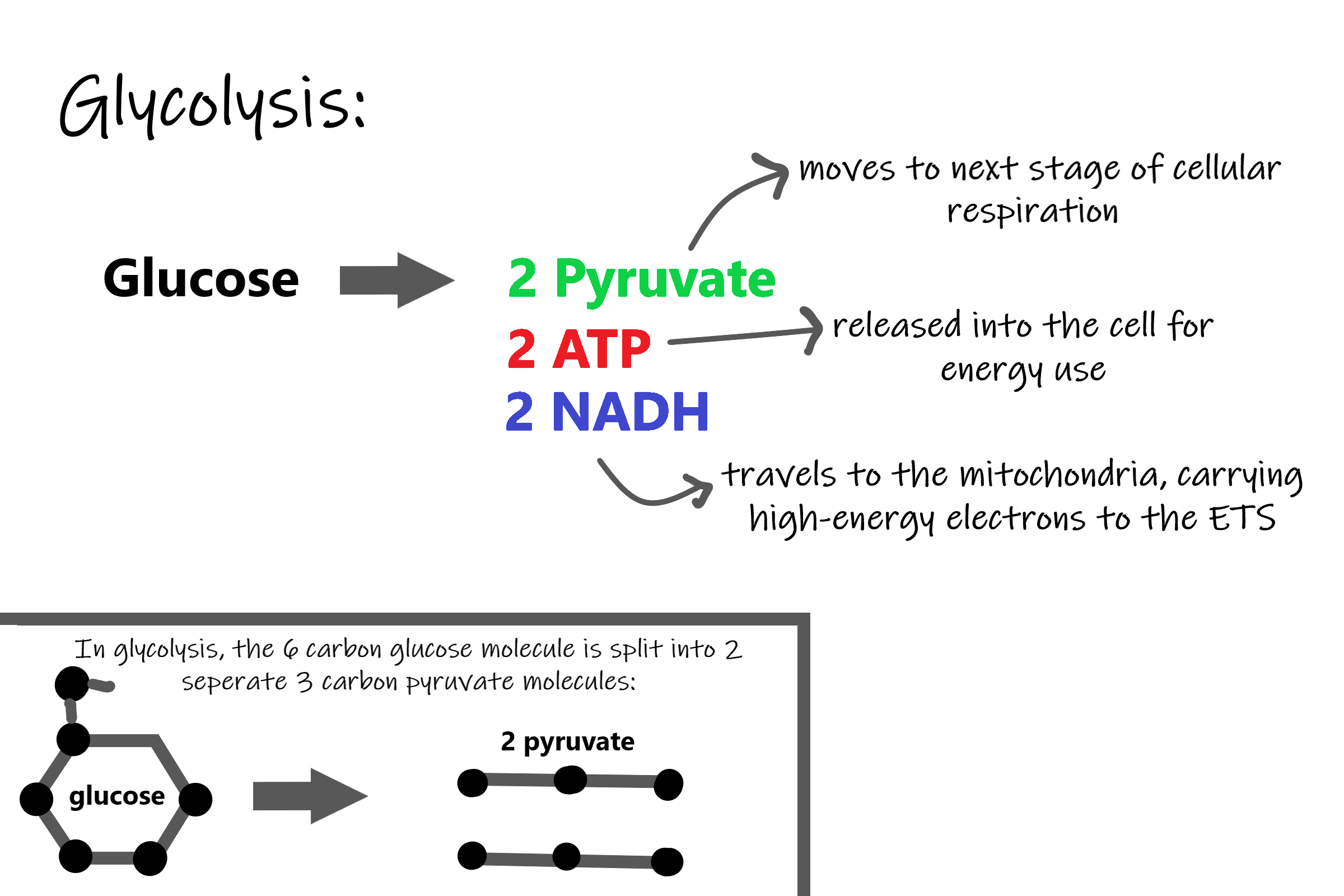
Results of Glycolysis
Energy is needed at the start of glycolysis to split the glucose molecule into two pyruvate molecules which go on to stage II of cellular respiration. The energy needed to split glucose is provided by two molecules of ATP; this is called the energy investment phase. As glycolysis proceeds, energy is released, and the energy is used to make four molecules of ATP; this is the energy harvesting phase. As a result, there is a net gain of two ATP molecules during glycolysis. During this stage, high-energy electrons are also transferred to molecules of NAD to produce two molecules of NADH, another energy-carrying molecule. NADH is used in stage III of cellular respiration to make more ATP.
Transition Reaction
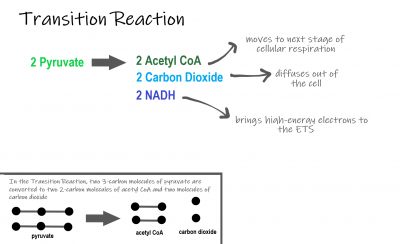
Before pyruvate can enter the next stage of aerobic cellular respiration in the mitochondrion it needs to be modified slightly. The transition reaction is a very short reaction which converts the two molecules of pyruvate to two molecules of acetyl CoA and carbon dioxide, and two pairs of high energy electrons from this process convert NAD to NADH. The carbon dioxide is released, the acetyl CoA enters the Citric Acid Cycle (stage II), and the NADH carries the high energy electrons to the Electron Transport System (stage III).
Structure of the Mitochondrion
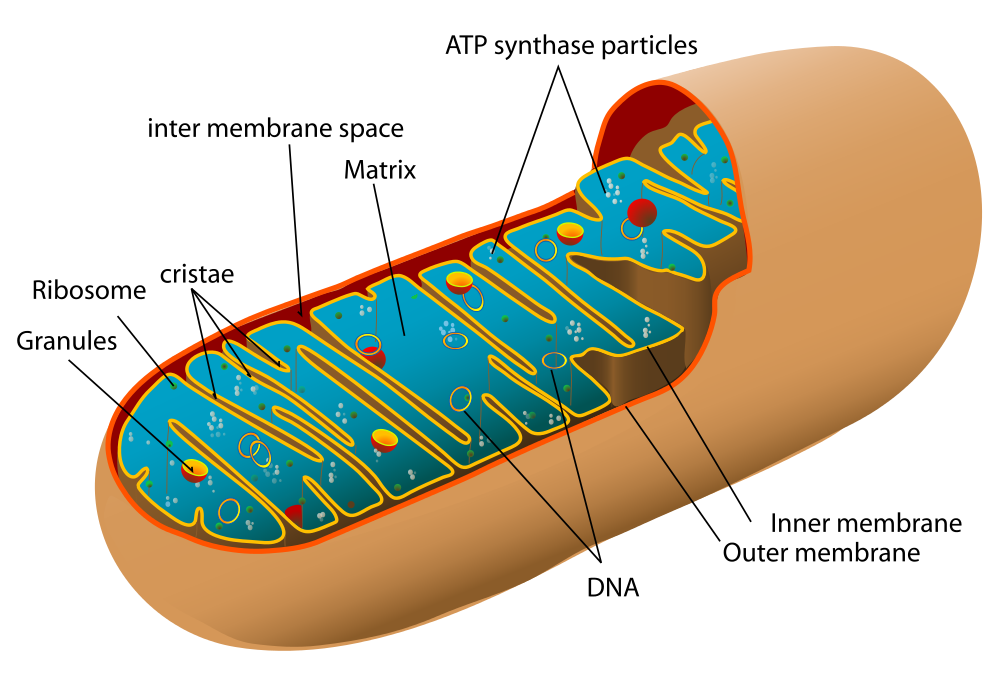
Before you read about the last two stages of cellular respiration, you need to know more about the mitochondrion, where these two stages take place. A diagram of a mitochondrion is shown in Figure 4.10.5.
The structure of a mitochondrion is defined by an inner and outer membrane. This structure plays an important role in aerobic respiration.
As you can see from the figure, a mitochondrion has an inner and outer membrane. The space between the inner and outer membrane is called the intermembrane space. The space enclosed by the inner membrane is called the matrix. The second stage of cellular respiration (the citric acid cycle) takes place in the matrix. The third stage (electron transport) happens on the inner membrane.
Cellular Respiration Stage II: The Citric Acid Cycle Cycle
Recall that glycolysis produces two molecules of pyruvate (pyruvic acid), which are then converted to acetyl CoA during the short transition reaction in the matrix of the mitochondrion, where they start the citric acid cycle (also known as the Kreb’s cycle). The reason this stage is considered a cycle is because a molecule called oxaloacetate is present at both the beginning and end of this reaction and is used to break down the two molecules of acetyl CoA. The reactions that occur next are shown in Figure 4.10.6.
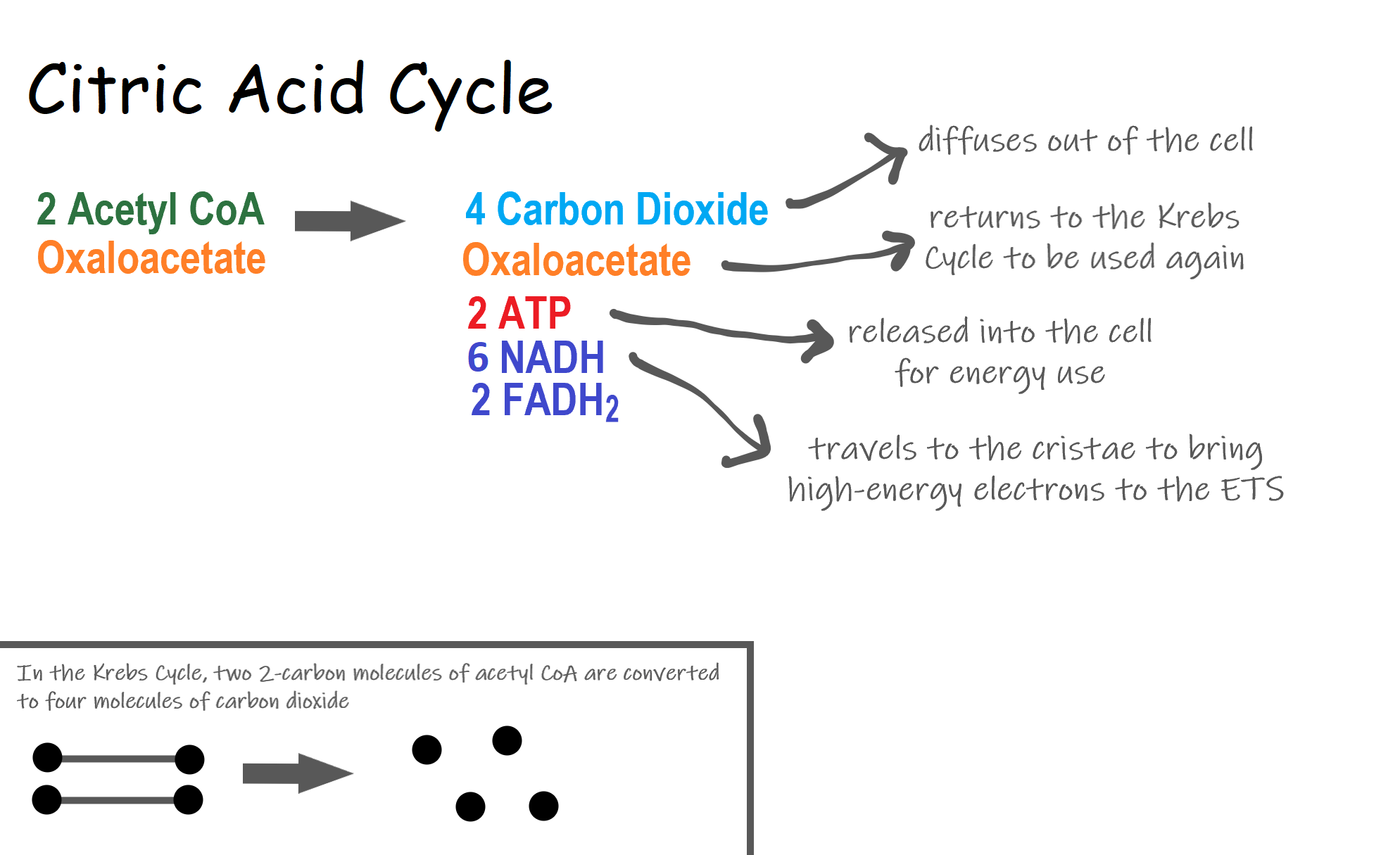
Steps of the Citric Acid Cycle
The citric acid cycle itself actually begins when acetyl-CoA combines with a four-carbon molecule called OAA (oxaloacetate) (see Figure 4.10.6). This produces citric acid, which has six carbon atoms.
After citric acid forms, it goes through a series of reactions that release energy. The energy is captured in molecules of NADH, ATP, and FADH2, another energy-carrying coenzyme. Carbon dioxide is also released as a waste product of these reactions.
The final step of the citric acid cycle regenerates OAA, the molecule that began the cycle. This molecule is needed for the next turn through the cycle. Two turns are needed because glycolysis produces two pyruvic acid molecules when it splits glucose.
Results of the Glycolysis, Transition Reaction and Citric Acid Cycle
After glycolysis, transition reaction, and the citric acid cycle, the glucose molecule has been broken down completely. All six of its carbon atoms have combined with oxygen to form carbon dioxide. The energy from its chemical bonds has been stored in a total of 16 energy-carrier molecules. These molecules are:
- 4 ATP (2 from glycolysis, 2 from citric acid cycle)
- 10 NADH (2 from glycolysis, 2 from transition reaction, and 6 from citric acid cycle)
- 2 FADH2 (both from the citric acid cycle)
The events of cellular respiration up to this point are exergonic reactions– they are releasing energy that had been stored in the bonds of the glucose molecule. This energy will be transferred to the third and final stage of cellular respiration: the Electron Transport System, which is an endergonic reaction. Using an exothermic reaction to power an endothermic reaction is known as energy coupling.
Cellular Respiration Stage III: Electron Transport Chain
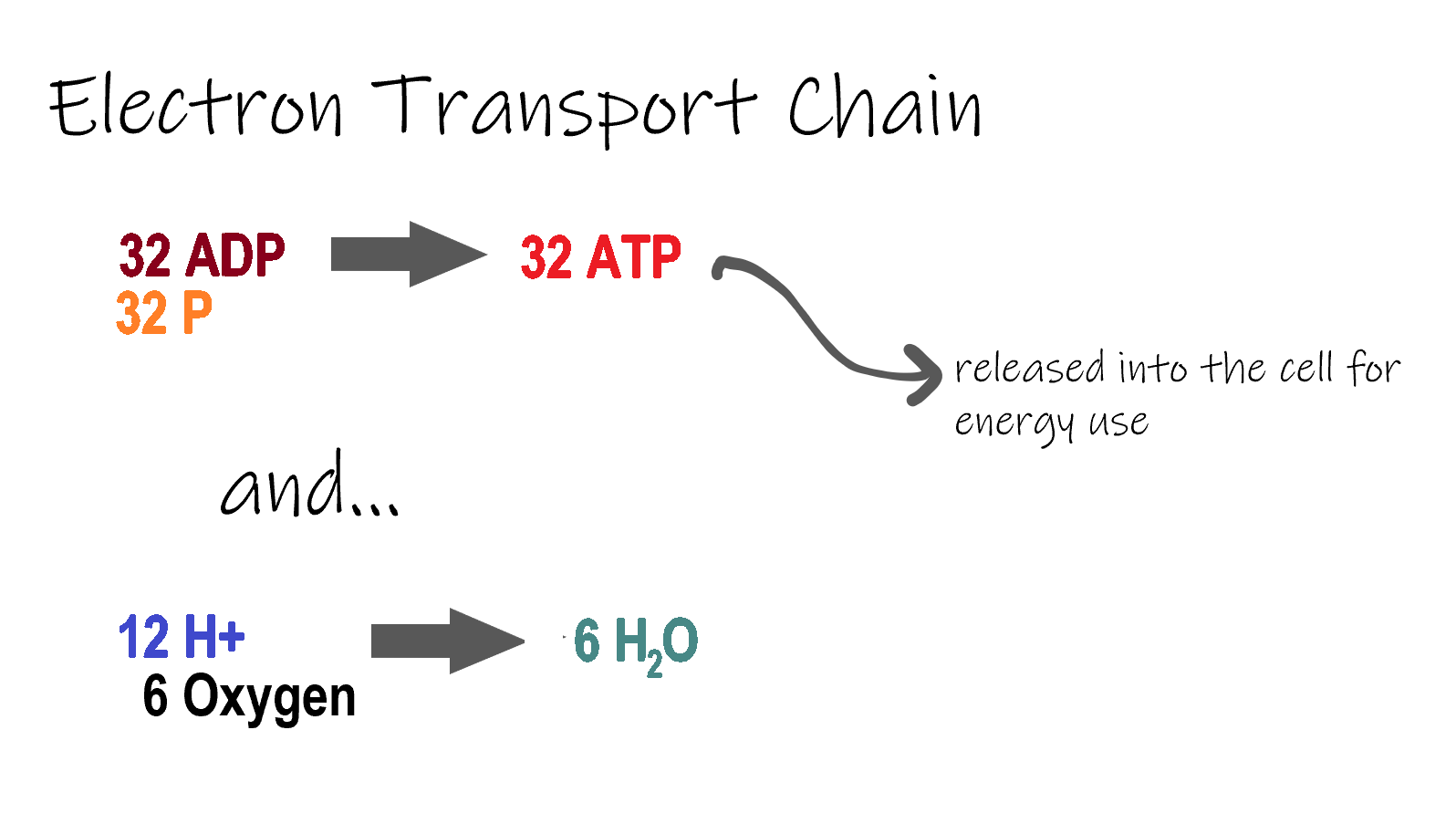
ETC, the final stage in cellular respiration produces 32 ATP. The Electron Transport Chain is the final stage of cellular respiration. In this stage, energy being transported by NADH and FADH2 is transferred to ATP. In addition, oxygen acts as the final proton acceptor for the hydrogens released from all the NADH and FADH2, forming water. Figure 4.10.8 shows the reactants and products of the ETC.
Transporting Electrons
The Electron transport chain is the third stage of cellular respiration and is illustrated in Figure 4.10.8. During this stage, high-energy electrons are released from NADH and FADH2, and they move along electron-transport chains on the inner membrane of the mitochondrion. An electron-transport chain is a series of molecules that transfer electrons from molecule to molecule by chemical reactions. Some of the energy from the electrons is used to pump hydrogen ions (H+) across the inner membrane, from the matrix into the intermembrane space. This ion transfer creates an electrochemical gradient that drives the synthesis of ATP.
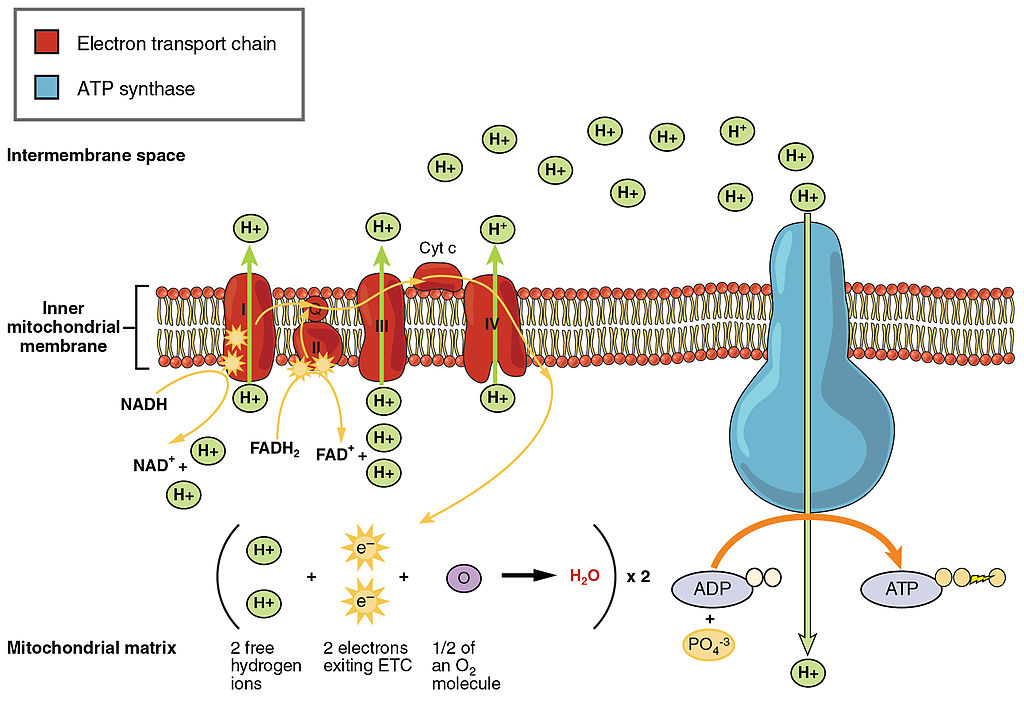
Making ATP
As shown in Figure 4.10.8, the pumping of hydrogen ions across the inner membrane creates a greater concentration of the ions in the intermembrane space than in the matrix. This gradient causes the ions to flow back across the membrane into the matrix, where their concentration is lower. ATP synthase acts as a channel protein, helping the hydrogen ions cross the membrane. It also acts as an enzyme, forming ATP from ADP and inorganic phosphate in a process called oxidative phosphorylation. After passing through the electron-transport chain, the “spent” electrons combine with oxygen to form water.
How Much ATP?
You have seen how the three stages of aerobic respiration use the energy in glucose to make ATP. How much ATP is produced in all three stages combined? Glycolysis produces two ATP molecules, and the citric acid cycle produces two more. Electron transport begins with several molecules of NADH and FADH2 from the citric acid cycle and transfers their energy into as many as 34 more ATP molecules. All told, then, up to 38 molecules of ATP can be produced from just one molecule of glucose in the process of cellular respiration.
4.10 Summary
- Cellular respiration is the aerobic process by which living cells break down glucose molecules, release energy, and form molecules of ATP. Generally speaking, this three-stage process involves glucose and oxygen reacting to form carbon dioxide and water.
- The first stage of cellular respiration, called glycolysis, takes place in the cytoplasm. In this step, enzymes split a molecule of glucose into two molecules of pyruvate, which releases energy that is transferred to ATP.
- The organelle called a mitochondrion is the site of the remaining stages of aerobic cellular respiration. The mitochondrion has an inner and outer membrane separated by an intermembrane space, and the inner membrane encloses a space called the matrix.
- The second stage of cellular respiration, called the citric acid or Kreb's cycle, takes place in the matrix of a mitochondrion. Following glycolysis, the pyruvate that has moved into the matrix of the mitochondrion must first be modified by the transition reaction. This short reaction converts the pyruvate into two molecules of acetyl CoA, each of which will enter the citric acid cycle. During this stage, two turns through the cycle result in all of the carbon atoms from the two pyruvate molecules forming carbon dioxide and the energy from their chemical bonds being stored in energy-carrying molecules.
- The third and final stage of cellular respiration, called electron transport, takes place on the inner membrane of the mitochondrion. Electrons are transported from molecule to molecule down an electron-transport chain. Some of the energy from the electrons is used to pump hydrogen ions across the membrane, creating an electrochemical gradient that drives the synthesis of many more molecules of ATP.
- In all three stages of cellular respiration combined, as many as 38 molecules of ATP are produced from just one molecule of glucose.
4.10 Review Questions
- What is the purpose of cellular respiration? Provide a concise summary of the process.
- State what happens during glycolysis.
- Describe the structure of a mitochondrion.
- What molecule is present at both the beginning and end of the citric acid cycle?
- What happens during the electron transport stage of cellular respiration?
- How many molecules of ATP can be produced from one molecule of glucose during all three stages of cellular respiration combined?
- Do plants undergo cellular respiration? Why or why not?
- Explain why the process of cellular respiration described in this section is considered aerobic.
- Name three energy-carrying molecules involved in cellular respiration.
-
- Which stage of aerobic cellular respiration produces the most ATP?
-
4.10 Explore More
https://www.youtube.com/watch?time_continue=2&v=00jbG_cfGuQ&feature=emb_logo
ATP & Respiration: Crash Course Biology #7, CrashCourse, 2012.
Cellular Respiration and the Mighty Mitochondria, The Amoeba Sisters, 2014.
Attributions
Figure 4.10.1
Smores by Jessica Ruscello on Unsplash is used under the Unsplash License (https://unsplash.com/license).
Figure 4.10.2
Carbohydrate_Metabolism by OpenStax College on Wikimedia Commons is used under a CC BY 3.0 (https://creativecommons.org/licenses/by/3.0) license.
Figure 4.10.3
Glycolysis by Christine Miller is used under a CC BY 4.0 (https://creativecommons.org/licenses/by/4.0/) license.
Figure 4.10.4
Transition Reaction by Christine Miller is used under a CC BY 4.0 (https://creativecommons.org/licenses/by/4.0/) license.
Figure 4.10.5
Mitochondrion by Mariana Ruiz Villarreal [LadyofHats] on Wikimedia Commons is released into the public domain (https://en.wikipedia.org/wiki/Public_domain).
Figure 4.10.6
Krebs cycle by Christine Miller is used under a CC BY 4.0 (https://creativecommons.org/licenses/by/4.0/) license.
Figure 4.10.7
Electron Transport Chain (ETC) by Christine Miller is used under a CC BY 4.0 (https://creativecommons.org/licenses/by/4.0/) license.
Figure 4.10.8
The_Electron_Transport_Chain by OpenStax College on Wikimedia Commons is used under a CC BY 3.0 (https://creativecommons.org/licenses/by/3.0) license.
References
CrashCourse. (2012, March 12). ATP & Respiration: Crash Course Biology #7. YouTube. https://www.youtube.com/watch?time_continue=2&v=00jbG_cfGuQ&feature=emb_logo
Betts, J. G., Young, K.A., Wise, J.A., Johnson, E., Poe, B., Kruse, D.H., Korol, O., Johnson, J.E., Womble, M., DeSaix, P. (2013, April 25). Figure 24.8 Electron Transport Chain [digital image]. In Anatomy & Physiology, Connexions (Section ). OpenStax. https://openstax.org/books/anatomy-and-physiology/pages/24-2-carbohydrate-metabolism
Betts, J. G., Young, K.A., Wise, J.A., Johnson, E., Poe, B., Kruse, D.H., Korol, O., Johnson, J.E., Womble, M., DeSaix, P. (2013, April 25). Figure 24.9 Carbohydrate Metabolism [digital image]. In Anatomy & Physiology, Connexions (Section 24.2). OpenStax. https://openstax.org/books/anatomy-and-physiology/pages/24-2-carbohydrate-metabolism
The Amoeba Sisters. (2014, October 22). Cellular Respiration and the Mighty Mitochondria. YouTube. https://www.youtube.com/watch?v=4Eo7JtRA7lg&t=3s
The rounded head (or tip) of the penis.
5.2 Chromosomes and Genes: Review Questions and Answers
- What are chromosomes and genes? How are the two related? Chromosomes are coiled structures made of DNA and proteins that form during cell division and are encoded with genetic instructions for making RNA and proteins. These instructions are organized into units called genes, which are segments of DNA that code for particular pieces of RNA. The RNA molecules can then act as a blueprint for proteins, or directly help regulate various cellular processes. There may be hundreds or even thousands of genes on a single chromosome.
- Describe human chromosomes and genes. Most human cells contain 23 pairs of chromosomes, for a total of 46 chromosomes. One set of chromosomes is inherited from each parent. Of the 23 pairs of chromosomes, 22 pairs are autosomes, which control traits unrelated to sex, and the remaining pair consists of sex chromosomes (XX or XY). Human chromosomes contain a total of 20,000 to 22,000 genes, the majority of which have two more possible versions, called alleles.
- Explain the difference between autosomes and sex chromosomes. Autosomes are chromosomes that contain genes unrelated to sex. They are the same in males and females. Sex chromosomes differ in males and females. Normal males have the chromosomes XY and females the chromosomes XX. Genes on the X chromosome are not related to sex. Only genes on the Y chromosome play a role in determining an individual's sex.
- What are linked genes, and what does a linkage map show? Linked genes are genes that are located on the same chromosome. A linkage map shows the location of specific genes on a chromosome.
- Explain why females are considered the default sex in humans. Females are considered the default sex in humans because only genes on the Y chromosome determine sex and trigger the development of the embryo into a male. Without a Y chromosome, an embryo will develop as female.
- Explain the relationship between genes and alleles. Alleles are different versions of the same gene.
- Most males and females have two sex chromosomes. Why do only females have Barr bodies? Only females usually have Barr bodies because Barr bodies refer to an inactivated X chromosome. This X chromosome is inactivated because cells should only have one functioning X chromosome. Since females have two X chromosomes, they need a Barr body, but since males are XY and only have one X chromosome, they do not have a Barr body.
- Self-marking
- Self-marking
5.3 DNA: Review Questions and Answers
- Outline the discoveries that led to the determination that DNA (not protein) is the biochemical molecule that contains genetic information. The first discovery that led to the determination that DNA is the biochemical molecule that contains genetic information was made in the 1920s, when Frederick Griffith showed that something in virulent bacteria could be transferred to nonvirulent bacteria and make them virulent as well. In the early 1940s, Oswald Avery and colleagues showed that the "something" Griffith found in his research was DNA and not protein. This result was confirmed by Alfred Hershey and Martha Chase who demonstrated that viruses insert DNA into bacterial cells so the cells will make copies of the viruses.
- State Chargaff's rules. Explain how the rules are related to the structure of the DNA molecule. Chargaff's rules state that, within the DNA of any given species, the concentration of adenine is always the same as the concentration of thymine, and the concentration of guanine is always the same as the concentration of cytosine. Bonds between nitrogen bases hold together the two polynucleotide chains of DNA. Adenine and guanine have a two-ring structure, whereas cytosine and thymine have just one ring. If two-ring adenine, for example, were to bond with two-ring guanine as well as with one-ring thymine, the distance between the two chains would be variable. However, when two-ring adenine bonds only with one-ring thymine, and two-ring guanine bonds only with one-ring cytosine, the distance between the two chains remains constant. This maintains the uniform shape of the DNA double helix and explains how Chargaff's rules are related to DNA's structure.
- Explain how the structure of a DNA molecule is like a spiral staircase. Which parts of the staircase represent the various parts of the molecule? The DNA molecule has a double-helix structure, which is similar to the structure of a spiral staircase. The sugar-phosphate backbones of the two polynucleotide chains of DNA are like the two outside edges, or sides, of the spiral staircase. The bonded nitrogen bases are like the steps.
- Self-marking
- Why do you think dead S-strain bacteria injected into mice did not harm the mice, but killed them when mixed with living (and normally harmless) R-strain bacteria? Answers may vary. Sample answer. The DNA from the S strain bacteria was what was making the R strain bacteria harmful. It appears that the S strain DNA requires living bacteria (such as the R bacteria) to be harmful to a host organism. Therefore, it could not hurt the mice when injected alone.
- In Griffith’s experiment, do you think the heat treatment that killed the bacteria also inactivated the bacterial DNA? Why or why not? No, because after heat treatment, the DNA from the S strain bacteria was able to make the R strain bacteria, which is normally harmless, deadly. So the DNA was still causing the same effects after the heat treatment, and therefore seemed to be functioning normally.
- Give one example of the specific evidence that helped rule out proteins as genetic material. Answers may vary, but may include evidence from Avery’s or Hershey and Chase’s experiments. Sample answer: When proteins were inactivated, the dead S strain bacteria were still able to cause the normally harmless R strain bacteria to become deadly. Therefore, proteins were not the genetic material being passed to the R strain bacteria.
5.4 DNA Replication: Review Questions and Answers
- Self-marking
- Why are Okazaki fragments formed? Because DNA polymerase only replicates DNA in one direction.
- Self-marking
5.5 RNA: Review Questions and Answers
- State the central dogma of molecular biology. The central dogma of molecular biology states that the genetic instructions encoded in DNA are first transcribed to RNA and then translated from RNA into a protein.
- Self-marking
- Self-marking
- Self-marking
5.6 Genetic Code: Review Questions and Answers
- Describe the genetic code and explain how it is "read". The genetic code consists of the sequence of nitrogen bases in a polynucleotide chain of DNA or RNA (A, G, C, and T or U). The four bases make up the "letters" of the code. The letters are combined in groups of three to form "words" called codons. There are 64 possible codons, and each codon codes for one amino acid or for a start or stop signal. The codon AUG is the start codon that establishes the reading frame of the code. After the AUG start codon, the next three bases are read as the second codon. The next three bases after that are read as the third codon, and so on. The sequence of bases is read, codon by codon, until a stop codon is reached. UAG, UGA, and UAA are all stop codons.
- Identify three important characteristics of the genetic code. The genetic code is universal, which means that the same code is found in all living things, providing evidence of common evolutionary origins of all organisms. The genetic code is unambiguous. This means that each codon codes for just one amino acid (or for start or stop). As a result, there is no mistaking which amino acid is encoded by a given codon. The genetic code is also redundant. This means that each amino acid is encoded by more than one codon. This helps prevent errors in protein synthesis because an accidental change in a single base often has no effect on which amino acid the codon encodes.
- Summarize how the genetic code was deciphered. The genetic code was deciphered by a series of ingenious experiments carried out mainly by Marshall Nirenberg, along with his colleague Heinrich Matthaei. These researchers added contents of bacterial cells to 20 test tubes. This was done to provide the "machinery" needed to synthesize proteins. They also added all 20 amino acids to the test tubes, with a different amino acid "tagged" by a radioactive element in each test tube. Then they added synthetic RNA containing just one type of base to each test tube, starting with the base uracil. They discovered that an RNA molecule consisting only of uracil bases produces a polypeptide chain of the amino acid phenylalanine. The researchers used similar experiments to determine that each codon consists of three bases and eventually to discover the codons for all 20 amino acids.
- Use the decoder above to answer the following questions:
- Is the code depicted in the table from DNA or RNA? How do you know? RNA, because RNA has U (uracil) as a base instead of T (thymine) which is found in DNA. This code shows only U, no T, so therefore it represents the code of RNA not DNA.
- Which amino acid does the codon CAA code for? Glutamine.
- What does UGA code for? UGA is a stop codon, so it causes the code to stop being read.
- Look at the codons that code for the amino acid glycine. How many of them are there and how are they similar and different? There are 4 codons for the amino acid glycine. They all start with GG, but what is different in each of them is their final base, which may be U, C, A, or G. (Note: this is a common pattern in the redundancy of the genetic code).
- Self-marking
5.7 Protein Synthesis: Review Questions and Answers
- Relate protein synthesis and its two major phases to the central dogma of molecular biology. The way proteins are synthesized in cells is summed up by the central dogma of molecular biology: DNA → RNA → Protein. The first phase of protein synthesis, called transcription, is the DNA → RNA part of the central dogma. The second phase of protein synthesis, called translation, is the RNA → Protein part of the central dogma.
- Explain how mRNA is processed before it leaves the nucleus. Before it leaves the nucleus, mRNA may be processed in several ways, including splicing, editing, and polyadenylation. Splicing removes introns (noncoding regions) from mRNA. Editing changes some of the nucleotides in mRNA, which allows different versions of proteins to be synthesized. Polyadenylation adds adenine bases to the mRNA, which serves several functions, such as helping mRNA leave the nucleus and protecting mRNA from enzymes that might break it down.
- What additional processes might a polypeptide chain undergo after it is synthesized? After a polypeptide chain is synthesized, it may assume a folded shape due to interactions among its amino acids. It may also bind with other polypeptides or with different types of molecules, such as lipids or carbohydrates.
- Where does transcription take place in eukaryotes? Transcription takes place in the nucleus of eukaryotic cells.
- Where does translation take place? Translation takes place at ribosomes, which are in the cytoplasm of a cell.
- Self-marking
5.8 Mutations: Review Questions and Answers
- Define mutation. Mutation is a random change in the sequence of bases in DNA or RNA.
- Identify causes of mutation. Mutations may occur spontaneously when errors occur during DNA replication or during the transcription of DNA during protein synthesis. Other mutations are caused by mutagens. Mutagens are environmental factors that cause mutations. They include radiation, certain chemicals, and some infectious agents.
- Compare and contrast germline and somatic mutations. Germline mutations occur in gametes and may be passed on to offspring. Every cell in the body of the offspring will then carry the mutation. Somatic mutations occur in other cells of the body than gametes. They are confined to a single cell and its daughter cells, and they cannot be passed on to offspring. They are likely to have little or no effect on the organism in which they occur.
- Describe chromosomal alterations, point mutations, and frameshift mutations. Identify the potential effects of each type of mutation. Chromosomal alterations are mutations that cause major changes in the structure of chromosomes. They are very serious and often result in the death of the organism in which they occur. If the organism survives, it may be affected in multiple ways. Point mutations are changes in a single nucleotide. Their effects depend on how they change the genetic code and may range from no effects to serious effects. Frameshift mutations change the reading frame of the genetic code. They are likely to have drastic effects on the encoded protein.
- Why do many mutations have neutral effects? Many mutations are neutral in their effects because they do not change the amino acids in the proteins they encode or because they are repaired before protein synthesis occurs.
- Give one example of a beneficial mutation and one example of a harmful mutation. Answers will vary. Sample answer: An example of a beneficial mutation is a mutation that is found in people in a small Italian town that protects from atherosclerosis. An example of a harmful mutation is the mutation that causes the genetic disorder cystic fibrosis.
- Self-marking
- Why do you think that exposure to mutagens (such as cigarette smoke) can cause cancer? Mutagens are things in the environment that can cause mutations. Mutations in genes that control the cell cycle can cause cancer. Therefore, mutagens can cause cancer by causing mutations in these genes.
- Explain why the insertion or deletion of a single nucleotide can cause a frameshift mutation. Because the genetic code is read in sets of three nucleotides (a set of three is a codon), adding or removing a single nucleotide throws the whole reading frame off by changing which three nucleotides make up each codon. All of the codons after the insertion or deletion will be changed because of this, resulting in what is known as a frameshift mutation.
- Compare and contrast missense and nonsense mutations. Missense and nonsense mutations are both point mutations, where a single nucleotide is changed. The difference is that missense mutations cause an amino acid to be changed, while nonsense mutations cause a premature stop codon to be produced.
- Explain why mutations are important to evolution. Mutations are important for evolution because they are the source of new genetic variation. This variation can lead to organisms being more or less well adapted to their environments, which, over time, leads to evolutionary changes through natural selection.
5.9 Regulation of Gene Expression: Review Questions and Answers
- Define gene expression. Gene expression means using a gene to make a protein.
- Why must gene expression be regulated? Gene expression must be regulated so that the correct proteins are made where and when they are needed. This is necessary, for example, so that different types of cells have different shapes and other traits that suit them for their particular functions.
- Explain how regulatory proteins may activate or repress transcription. Regulatory proteins regulate the transcription phase of protein synthesis by binding to regions of DNA called regulatory elements, which are located near promoters. Regulatory proteins typically either activate or repress transcription. Activators promote transcription by enhancing the interaction of RNA polymerase with the promoter, thus initiating transcription of DNA to mRNA. Repressors prevent transcription by impeding the progress of RNA polymerase along the DNA strand so the DNA cannot be transcribed to mRNA.
- Self-marking
- What is the TATA box, and how does it work? The TATA box is a regulatory element that is part of the promoter of almost every eukaryotic gene. A number of regulatory proteins bind to the TATA box, forming a multi-protein complex. It is only when all of the appropriate proteins are bound to the TATA box that RNA polymerase recognizes the complex and binds to the promoter so transcription can begin.
- Describe homeobox genes and their role in an organism's development. Homeobox genes are a large group of similar genes that direct the formation of many body structures during the embryonic stage. In humans, homeobox genes code for chains of 60 amino acids called homeodomains. Proteins containing homeodomains are transcription factors that bind to and control the activities of other genes. They turn on certain genes in particular cells at just the right time so the individual develops normal organs and organ systems.
- Discuss the role of regulatory gene mutations in cancer. Mutations in regulatory genes that normally control the cell cycle can lead to certain types of cancer. Cancer-causing mutations most often occur in two types of regulatory genes, called proto-oncogenes genes and tumor-suppressor genes. Proto-oncogenes normally help cells divide. When a proto-oncogene mutates to become an oncogene, it is expressed continuously, so the cell keeps dividing out of control, which can lead to cancer. Tumor-suppressor genes normally slow down or stop cell division. When a tumor-suppressor gene mutates, cell division can't be slowed or stopped. The cell keeps dividing out of control, which can lead to cancer.
- Explain the relationship between proto-oncogenes and oncogenes. Proto-oncogenes are genes that normally help cells divide. An oncogene is a mutated form of a proto-oncogene that causes the gene to be expressed continuously. This can cause cancer.
- If a newly fertilized egg contained a mutation in a homeobox gene, how do you think this would affect the developing embryo? Explain your answer. Answers may vary. Sample answer: Because homeobox genes are important for the development of body structures in the embryo, including the development of organs and organ systems, I think that a mutation in one of these genes might cause the embryo to be significantly malformed. This might even result in death.
- Compare and contrast enhancers and activators. Enhancers and activators both promote gene expression. However, enhancers are distant regions of DNA and activators are proteins that bind to regulatory elements on the DNA, near the promoter region of the gene.
5.10 Mendel's Experiments and Laws of Inheritance: Review Questions and Answers
- Why were pea plants a good choice for Mendel's experiments? Pea plants were a good choice for Mendel's experiments because they are fast growing and easy to raise. They also have several visible characteristics that vary, such as seed form, flower colour, and stem length.
- Self-marking
- How did the outcome of Mendel's second set of experiments lead to his second law? In Mendel's second set of experiments, he investigated two characteristics at a time. For example, he crossed plants with yellow round seeds and plants with green wrinkled seeds. The plants in the F1 generation were all alike and had the same combination of characteristics (yellow round seeds) like one of the parents, whereas the plants in the F2 generation showed all possible combinations of the two characteristics, such as greenround seeds and yellow wrinkled seeds. This outcome showed that the factors controlling different characteristics are inherited independently of each other.
- Discuss the development of Mendel's legacy. During Mendel's lifetime, his work was largely ignored. It was only after Mendel's results were obtained by other researchers in 1900 that his work was rediscovered and he was given the credit he was due. Now, Mendel is considered the father of genetics for his experiments and the laws he derived from them.
- If Mendel’s law of independent assortment was not correct, and characteristics were always inherited together, what types of offspring do you think would have been produced by crossing plants with yellow round seeds and green wrinkled seeds? Explain your answer. There would be only offspring with yellow round seeds and green wrinkled seeds because those characteristics would always be inherited together. The other combinations would not have been observed.
5.11 Genetics of Inheritance: Review Questions and Answers
- Define genetics. Genetics is the science of heredity.
- Why is Gregor Mendel called the father of genetics if genes were not discovered until after his death? Gregor Mendel is called the father of genetics because his laws of inheritance form the basis of the science of heredity. Mendel thought some type of "factors" control traits and are passed on to offspring, and his laws describe how the factors and the traits they control are inherited. We now call Mendel's factors genes, and his laws of inheritance are now expressed in genetic terms.
- Self-marking
- Imagine that there are two alleles, R and r, for a given gene. R is dominant to r. Answer the following questions about this gene:
- What are the possible homozygous and heterozygous genotypes? The homozygous genotypes would be RR and rr, and the heterozygous genotype would be Rr.
- Which genotype or genotypes express the dominant R phenotype? Explain your answer. RR and Rr would express the dominant R phenotype because only one dominant allele (in this case, R) is needed to express the dominant phenotype.
- Are R and r on different loci? Why or why not? R and r cannot be on different loci because they are alleles of the same gene.
- Can R and r be on the same exact chromosome? Why or why not? If not, where are they located? No, because there is only one version of a gene on a single chromosome. They are on homologous chromosomes.
5.12 Sexual Reproduction, Meiosis, and Gametogenesis: Review Questions and Answers
- Self-marking
- Explain how sexual reproduction happens at the cellular level. At the cellular level, sexual reproduction occurs when two parents produce reproductive cells called gametes that unite to form offspring. Gametes are haploid cells and when they unite in the process of fertilization, they produce a diploid cell called a zygote.
- Summarize what happens during Meiosis. During meiosis, homologous chromosomes separate and the cell undergoes two cell divisions to form four haploid daughter cells. Each daughter cell has just one chromosome from each homologous pair. The two cell divisions that occur during meiosis are called meiosis I and meiosis II, and each of them occurs in four phases: prophase, metaphase, anaphase, and telophase.
- Compare and contrast gametogenesis in males and females. Gametogenesis is the process in which haploid daughter cells from meiosis change to become mature gametes. Gametes produced by males are called sperm, and they mature during a process known as spermatogenesis. Gametes produced by females are called eggs, and they mature during a process known as oogenesis.
- Explain the mechanisms that increase genetic variation in the offspring produced by sexual reproduction. Mechanisms that increase genetic variation in offspring produced by sexual reproduction include crossing-over, independent assortment, and the random union of gametes. Crossing-over is the exchange of genetic material between non-sister chromatids of homologous chromosomes that may occur during meiosis. It results in new combinations of genes on each chromosome. Independent assortment refers to the way in which different chromosomes are distributed randomly to daughter cells during meiosis. It results in gametes that have unique combinations of chromosomes. Which two of the millions of possible gametes that are produced by two parents actually unite to produce an offspring is likely to be a matter of chance and is another major source of genetic variation in offspring.
- Why do gametes need to be haploid? What would happen to the chromosome number after fertilization if they were diploid? Gametes need to be haploid (i.e. half the number of chromosomes) because during fertilization, two of them join together to make a diploid (i.e. the usual number of chromosomes) zygote. If gametes were diploid, the resulting zygote would have twice the normal amount of chromosomes, which would be problematic.
- Describe one difference between Prophase I of Meiosis and Prophase of Mitosis. Answers may vary. Sample answer: In prophase I of meiosis, homologous chromosomes pair up, which does not occur in prophase of mitosis.
- Do all of the chromosomes that you got from your mother go into one of your gametes? Why or why not? This would be highly unlikely, because homologous chromosomes segregate independently from each other into daughter cells during meiosis. So the chances of all 23 of the chromosomes that you got from your mother going into one of your gametes is very low.
5.13 Mendelian Inheritance: Review Questions and Answers
- Define genetic traits and Mendelian inheritance. Genetic traits are characteristics that are encoded in DNA. Mendelian inheritance refers to the inheritance of traits controlled by a single gene with two alleles, one of which may be completely dominant to the other.
- Self-marking
- Explain why autosomal and X-linked Mendelian traits have different patterns of inheritance. Autosomal Mendelian traits do not differ between males and females. They are inherited in the same way regardless of the sex of the parent or offspring. For example, a dominant autosomal trait will show up in anyone who inherits even one copy of the dominant allele, whereas the recessive trait will show up only in people who inherit two copies of the recessive allele. X-linked Mendelian traits, in contrast, have a different pattern of inheritance than autosomal Mendelian traits because males have just one X chromosome, which they always inherit from their mother and pass on to all of their daughters but none of their sons. A recessive X-linked trait, for example, will show up in males who inherit just one copy of the recessive allele, whereas females must inherit two copies of the recessive allele (one on each of their two X chromosomes) to express the recessive trait.
- Identify examples of human autosomal and X-linked Mendelian traits. Answers may vary. Sample answer: Examples of human autosomal Mendelian traits include albinism and Huntington's disease. Examples of human X-linked Mendelian traits include red-green colour blindness and hemophilia.
- Imagine a hypothetical human gene that has two alleles,Q and q. Q is dominant to q and the inheritance of this gene is Mendelian. Answer the following questions about this gene.
- If a woman has the genotype Q q and her husband has the genotype QQ, list each of their possible gametes. What proportion of their gametes will have each allele? The woman’s gametes will be 50%Q and 50% q. Her husband’s gametes will be 100% Q.
- What are the likely proportions of their offspring being QQ, Qq, or qq? Their offspring have a 50% chance of being QQ, a 50% chance of being Qq, and a zero per cent chance of being qq. (Hint: if you are having trouble figuring this out, make a Punnett square).
- Is this an autosomal trait or an X-linked trait? How do you know? This must be an autosomal trait because the man has two alleles for the gene (i.e. he isQQ). X-linked traits have only one copy of the gene in males because males have only one X chromosome.
- What are the chances of their offspring exhibiting the dominant Q trait? Explain your answer. Their offspring will all have the dominant Q trait, because their genotypes will either be QQ or Qq, and only one copy of the dominant Q allele is needed to express the dominant trait.
- Explain why fathers always pass their X chromosome down to their daughters. Fathers pass their single X chromosome down to their daughters because women have two X chromosomes and therefore receive one X chromosome from each parent.
5.14 Non-Mendelian Inheritance: Review Questions and Answers
- What is non-Mendelian inheritance? Non-Mendelian inheritance is the inheritance of traits that have a more complex genetic basis than one gene with two alleles and complete dominance.
- Self-marking
- Explain why the human ABO blood group is an example of a multiple allele trait with codominance. The human ABO blood group is an example of a multiple allele trait because the gene for ABO blood type has more than two commonly occurring alleles: IA, IB, and i. ABO blood group is an example of codominance because the IAand IB alleles are codominant to one another. As a result, heterozygotes who inherit one copy of each allele produce both A and B antigens, giving them type AB blood.
- What is incomplete dominance? Give an example of this type of non-Mendelian inheritance in humans. Incomplete dominance is the case in which the dominant allele for a gene is not completely dominant to a recessive allele for the gene, so an intermediate phenotype occurs in heterozygotes who inherit both alleles. A human example of incomplete dominance is Tay Sachs disease, in which heterozygotes produce half as much functional enzyme as normal homozygotes.
- Explain the genetic basis of human skin colour. Human skin colour is a polygenic trait. It is controlled by several different genes, each with more than one allele. The alleles of each gene have a minor additive effect on the phenotype, producing a whole continuum of possible phenotypes and gradations of skin colour.
- How can the human trait of adult height be influenced by the environment? The human trait of adult height is a polygenic trait, and the environment may affect the phenotypic expression of the trait. For example, if a child's growth is negatively affected by poor nutrition or illness, the child may grow up to be shorter in stature than would otherwise be the case given the child's genes for height.
- Define pleiotropy, and give a human example. Pleiotropy is the situation in which one gene has multiple phenotypic effects. Examples may vary. Sample answer: A human example of pleiotropy involves the gene that codes for the main protein in collagen, a substance that helps form bones and is also important in the ears and eyes. Mutations in the gene result in problems not only in bones but also in these sensory organs, which is how the gene's pleiotropic effects were discovered.
- Compare and contrast epistasis and dominance. Epistasis is the case in which a gene affects the expression of other genes. For example, a mutation in one gene may not allow other genes to be expressed in the phenotype. This occurs with albinism, for example. Dominance is the case in which one allele masks the expression of another allele for the same gene. Epistasis is similar to dominance, except that it occurs between different genes rather than between different alleles for the same gene.
- What is the difference between pleiotropy and epistasis? Pleiotropy is when one gene affects more than one phenotypic trait. Epistasis is when one gene affects the expression of other genes.
5.15 Genetic Disorders: Review Questions and Answers
- Define genetic disorder. A genetic disorder is a disease, syndrome, or other abnormal condition that is caused by gene mutation(s) or by chromosomal alterations.
- Identify three genetic disorders caused by mutations in a single gene. Answers may vary. Sample answer: Three genetic disorders caused by mutations in a single gene are Marfan syndrome (autosomal dominant), sickle cell anemia (autosomal recessive), and hemophilia A (X-linked recessive).
- Why are single-gene genetic disorders more commonly controlled by recessive than dominant mutant alleles? Single-gene genetic disorders are more commonly controlled by recessive than dominant mutant alleles because a dominant allele is always expressed. If it causes a serious genetic disorder, individuals who inherit even one copy of the allele may not live long enough to reproduce and pass on the allele to offspring. As a result, the allele is likely to die out of the population. A recessive mutant allele, in contrast, is not expressed in people who inherit just one copy of it. They carry the mutant allele and their offspring can inherit it. Thus, a recessive mutant allele is more likely than a dominant mutant allele to pass on to the next generation rather than die out.
- What is nondisjunction? Why can it cause genetic disorders? Nondisjunction is the failure of replicated chromosomes to separate properly during meiosis. Some of the resulting gametes will be missing all or part of a chromosome, while others will have an extra copy of all or part of the chromosome. If such a gamete is fertilized and forms a new individual, the individual is likely to have a serious genetic disorder.
- Explain why genetic disorders caused by abnormal numbers of chromosomes most often involve the X chromosome. Genetic disorders caused by abnormal numbers of chromosomes most often involve the X chromosome because the X and Y chromosomes are very different in size, making nondisjunction more frequent for the sex chromosomes.
- How is Down syndrome detected in utero? One way of detecting Down syndrome in utero is to extract a few fetal cells from the fluid surrounding the fetus and examine the fetal chromosomes. If an extra copy of chromosome 21 is present, the fetus has Down syndrome.
- Use the example of PKU to illustrate how the symptoms of a genetic disorder can sometimes be prevented. PKU is a genetic disorder in which the individual lacks a normal enzyme needed to break down the amino acid phenylalanine, which builds up in the body and causes the symptoms of PKU. If a low-phenylalanine diet is followed throughout life, the symptoms of PKU can be prevented.
- Explain how gene therapy works. Gene therapy works by inserting a normal gene in cells with a mutant gene, so the protein encoded by the gene can be synthesized in cells. A vector, such as a virus, is genetically engineered to deliver the normal gene by infecting cells. If the treatment is successful, the new gene delivered by the vector will allow the synthesis of a functioning protein.
- Compare and contrast genetic disorders and congenital disorders. Genetic disorders and congenital disorders both can be present at birth, but genetic disorders are specifically caused by problems in genes or chromosomes, while congenital disorders may be due to any cause.
- Explain why parents that do not have Down syndrome can have a child with Down syndrome. Answers may vary. Sample answer: Down syndrome is caused by a mistake during meiosis that produces gametes with an extra copy (complete or partial) of chromosome 21. It is only the parent’s gamete or gametes that are affected. If a gamete with this chromosomal abnormality goes on to create a zygote, the child that results will have Down syndrome.
- Hemophilia A and Turner’s syndrome both involve problems with the X chromosome. In terms of how the X chromosome is affected, what is the major difference between these two types of disorders? Answers may vary. Sample answer: Hemophilia A is a single gene mutation on the X chromosome, while Turner’s syndrome involves the loss of an entire X chromosome (XO).
- Can you be a carrier of Marfan syndrome and not have the disorder? Explain your answer. No, because Marfan syndrome is dominant. Even one copy of the gene will cause the disorder. Carriers refer to people with one copy of a recessive gene.
5.16 Genetic Engineering: Review Questions and Answers
Review Questions
- Define genetic engineering Genetic engineering is the use of technology to change the genetic makeup of living things for human purposes.
- Self-marking
- What is recombinant DNA? Recombinant DNA is DNA that is formed by combining DNA from two different species of organisms.
- Identify the steps of gene cloning. The steps of gene cloning are isolation, ligation, transformation, and selection. During isolation, a gene is isolated by using an enzyme to break DNA. During ligation, another enzyme is used to combine the isolated gene with plasmid DNA from bacteria, producing recombinant DNA. In transformation, the recombinant DNA is inserted into another cell, usually a bacterial cell. During selection, transformed bacteria are grown to make sure they have the recombinant DNA and only those that do are selected for further use.
- What is the purpose of the polymerase chain reaction? The purpose of the polymerase chain reaction is to make many copies of a gene or other DNA segment. This might be done in order to have large quantities of the gene for genetic testing.
- Make a flow chart outlining the steps involved in creating a transgenic crop. Flow charts may vary but should include the following steps in creating a transgenic crop: a. Plasmid DNA is obtained from bacteria that infect plants. b. Recombinant DNA is created by combining a desired gene with the plasmid DNA from the bacteria. c. The recombinant DNA is re-inserted into a bacterium. d. The transformed bacterium is used to insert the recombinant DNA into the chromosome of a plant cell. e. The plant cell is grown in culture. f. A plant cell clone from the culture is used to generate a plant with the desired gene.
- Explain how bacteria can be genetically engineered to produce a human protein. To genetically engineer bacteria to produce a human protein, gene cloning is used to form recombinant DNA that contains the normal human gene for the protein and plasmid DNA from bacteria. The recombinant DNA is re-inserted into the bacteria. The bacteria can multiply rapidly and produce large amounts of the human protein.
- Identify an ethical, legal, or social issue raised bygenetic engineering. State your view on the issue, and develop a logical argument to support your view. Answers may vary but should identify an ethical, legal, or social issue raised by genetic engineering; a clearly stated view on the issue; and a logical argument to support the view. Sample topics might include health, safety, privacy, and environmental issues.
- Explain what primers are and what they do in PCR. Primers are short pieces of DNA that have a complementary base sequence to a DNA strand that is being used to make copies of a gene. Primers bind to the DNA strand during the annealing stage of PCR. Then an enzyme adds nucleotides to the primer to make new DNA molecules, which contain copies of the gene.
- The enzyme Taq polymerase was originally identified from bacteria that live in very hot environments, such as hotsprings. Why does this fact make Taq polymerase particularly useful in PCR reactions? Taq polymerase is particularly useful for PCR reactions because it can function in the hot temperatures necessary for PCR, due to the fact that it comes from bacteria that live in extremely hot environments.
5.17 The Human Genome: Review Questions and Answers
Review Questions
- Describe the human genome. The human genome refers to all the DNA of the human species. It consists of 3.3 billion base pairs divided into 20,500 genes on 23 pairs of chromosomes.
- What is the Human Genome Project? The Human Genome Project is a multi-billion dollar, international biological research project that began in 1990, continued to 2003, and involved researchers at 20 universities in several different countries.
- Identify two main goals of the Human Genome Project. Two main goals of the Human Genome Project were to sequence all of the DNA base pairs in the human genome, and to map the location and determine the function of all the genes in the human genome.
- What is the reference genome of the Human Genome Project? What is it based on? The reference genome of the Human Genome Project is the sequence of DNA base pairs in a complete set of human chromosomes. It is based on a combined mosaic of a small number of anonymous donors, all of European origin.
- Explain how knowing the sequence of DNA bases in the human genome is beneficial for molecular medicine. Knowing the sequence of DNA bases in the human genome is beneficial for molecular medicine because it is helping researchers identify mutations linked to different forms of cancer, yielding insights into the genetic basis of many diseases, such as cystic fibrosis, and helping researchers tailor medications to individual genotypes.
- What was one surprising finding of the Human Genome Project? Answers may vary. Sample answer: One surprising finding of the HGP was the relatively small number of genes in humans.
- Why do you think scientists didn’t just sequence the DNA from a single person for the Human Genome Project? Along those lines, why do you think it is important to include samples from different ethnic groups and genders in genome sequencing efforts? Answers may vary. Sample answer: Although all humans share the same basic genes, there is some variation in the specific sequences between individuals. If only one person was sequenced, that sequence would not necessarily be a good representative of the human species as a whole. That is why scientists sequenced several individuals and came up with a composite reference sequence. This is also why different ethnic groups and genders should be included in genome sequencing efforts, because the range of human variation should be represented to better reflect the genome of the human species as a whole.
- What is pharmacogenomics? Pharmacogenomics is the study of how an individual’s genes affect the way they respond to drugs.
- If a patient were to have pharmacogenomics done to optimize their medication, what do you think the first step would be? Answers may vary.Sample answer: I think the first step would be for the patient to have a test to find out the sequence of a gene or genes in their body that could affect how the medication is activated or deactivated.
- List one advantage and one disadvantage of pharmacogenomics. Answers may vary.Sample answer: One advantage of pharmacogenomics is that doctors might be able to find the most effective medication for a specific patient more quickly. One disadvantage is that this technique is currently often not covered by insurance and can be expensive.
- Explain how the sequencing of the human genome relates to ethical concerns about genetic discrimination. Answers may vary.Sample answer: By sequencing the human genome, genes associated with certain diseases can be discovered. This can lead to ethical concerns about potential discrimination against individuals with these genetic sequences, for instance by insurance companies or employers, who have a vested interest in having healthy clients or employees.
Chapter 5 Case Study Conclusion: Review Questions and Answers
- Self-marking
- What are the differences between a sequence of DNA and the sequence of mature mRNA that it produces? Answers may vary. Sample answer: Directly after transcription, an RNA sequence is complementary to the DNA sequence that it is transcribed from, but RNA contains uracil (U) instead of the thymine (T) base that is used in DNA. Then the pre-mRNA is spliced to remove introns, possibly edited, and a “tail” of adenines is added through polyadenylation. Therefore, the mature mRNA sequence is significantly different than simply being the complementary sequence to the DNA sequence.
- Scientists sometimes sequence DNA that they “reverse transcribe” from the mRNA in an organism’s cells, which is called complementary DNA (cDNA). Why do you think this technique might be particularly useful for understanding an organism’s proteins versus sequencing the whole genome (i.e. nuclear DNA) of the organism? Answers may vary. Sample answer: I think this technique might be useful because the mRNA only contains the exons that code for amino acids and, ultimately, proteins. Nuclear DNA contains a lot of regions that do not code for proteins. Therefore, you might be able to gain insight into the proteins that an organism produces more quickly if you sequence the cDNA made from mRNA, rather than starting with the nuclear DNA of the entire genome.
- A person has a hypothetical Aa genotype. Answer the following questions about this genotype:
- What do A and a represent? A and a are different alleles of the same gene.
- If the person expresses only the phenotype associated with A, is this an example of complete dominance, codominance, or incomplete dominance? Explain your answer. Also, describe what the observed phenotypes would be if it were either of the two incorrect answers. This is an example of complete dominance because A completely dominates the phenotype over a. If it were codominance, the phenotypes for A and a would both be expressed. If it were incomplete dominance, you might see an intermediate phenotype that is between the phenotypes for A and a.
- Explain how a mutation that occurs in a parent can result in a genetic disorder in their child. Be sure to include which type of cell or cells in the parent must be affected in order for this to happen. Answers may vary. Sample answer: A gene mutation in a parent’s gametes, otherwise known as a germline mutation, can be passed down to their offspring. If this mutation results in a protein that does not function normally, it can cause a genetic disorder in the child.
- What is the term for an allele that is not expressed in a heterozygote? A recessive allele.
- What might happen if codons encoded for more than one amino acid? Answers may vary. Sample answer. If codons encoded for more than one amino acid, tRNA would bring various amino acids to the ribosome for each codon, resulting in varied proteins. These may have different functions and be detrimental to the organism.
- Explain why a human gene can be inserted into bacteria and can still produce the correct human protein, despite being in a very different organism. A human gene inserted into bacteria still produces the same human protein because the genetic code is universal, meaning that it is the same among all living organisms.
- What is gene therapy? Why is gene therapy considered a type of biotechnology? Gene therapy is an experimental technique to treat genetic disorders. In gene therapy, a normal gene is inserted into human cells to compensate for an abnormally functioning gene. This is often done using viruses as vectors to carry and insert the new DNA. Gene therapy is a type of genetic engineering because it involves changing the genetic makeup of an organism.
Created by: CK-12/Adapted by Christine Miller
Figure 5.16.1 Potato plants: One genetically engineered and healthy (left), and one infected with bacterial ring rot (right).
Please Pass the Potatoes
You might want to pass on the potato plants on the right in Figure 5.16.1. They are infected with a virus, which is quickly killing them. The potato plants on the left are healthy and productive. Why aren't they infected with the same virus? The plants on the left have been genetically engineered to make them resistant to the virus.
What Is Genetic Engineering?
Genetic engineering is the use of technology to change the genetic makeup of living things for human purposes. Generally, the goal of genetic engineering is to modify organisms so they are more useful to humans. Genetic engineering, for example, may be used to create crops that yield more food or resist insect pests or viruses, such as the virus-resistant potatoes pictured (left) in Figure 5.16.1 . Research is also underway to use genetic engineering to cure human genetic disorders with gene therapy.
Genetic Engineering Methods
Genetic engineering uses a variety of techniques to achieve its aims. Two commonly used techniques are gene cloning and the polymerase chain reaction.
Gene Cloning
Gene cloning is the process of isolating and making copies of a gene. This is useful for many purposes. For example, gene cloning might be used to isolate and make copies of a normal gene for gene therapy. Gene cloning involves four steps: isolation, ligation, transformation, and selection.
- In the isolation step, an enzyme is used to break DNA at a specific base sequence. This is done to isolate a gene.
- During ligation, the enzyme DNA ligase combines the isolated gene with plasmid DNA from bacteria. (Plasmid DNA is circular DNA that is not part of a chromosome and can replicate independently). The DNA that results is called recombinant DNA.
- In transformation, the recombinant DNA is inserted into a living cell, usually a bacterial cell.
- Selection involves growing transformed bacteria to make sure they have the recombinant DNA. This is a necessary step because transformation is not always successful. Only bacteria that contain the recombinant DNA are selected for further use.
Polymerase Chain Reaction
The polymerase chain reaction (PCR) makes many copies of a gene or other DNA segment. This might be done in order to make large quantities of a gene for genetic testing. PCR involves three steps: denaturing, annealing, and extension. The three steps are illustrated in Figure 5.16.2. They are repeated many times in a cycle to make large quantities of the gene.
- Denaturing involves heating DNA to break the bonds holding together the two DNA strands, yielding two single strands of DNA.
- Annealing involves cooling the single strands of DNA and mixing them with short DNA segments called primers. Primers have base sequences that are complementary to segments of the single DNA strands. As a result, bonds form between the DNA strands and primers.
- Extension [or Elongation] occurs when an enzyme (Taq polymerase or Taq DNA polymerase) adds nucleotides to the primers. This produces new DNA molecules, each incorporating one of the original DNA strands.

Uses of Genetic Engineering
Methods of genetic engineering can be used for many practical purposes. They are used widely in both medicine and agriculture.
Applications in Medicine
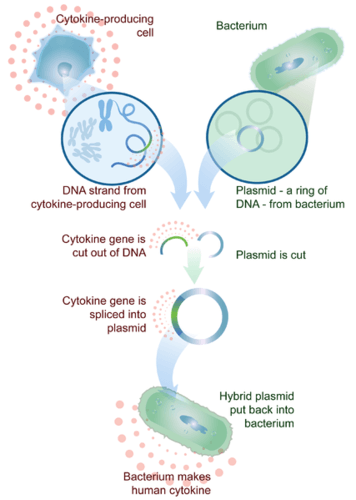
In addition to gene therapy for genetic disorders, genetic engineering can be used to transform bacteria so they are able to make human proteins (see Figure 5.16.3). Proteins made by the bacteria are injected into people who cannot produce them because of mutations.
Insulin was the first human protein to be produced in this way. Insulin helps cells take up glucose from the blood. People with type 1 diabetes have a mutation in the gene that normally codes for insulin. Without insulin, their blood glucose rises to harmfully high levels. At present, the only treatment for type 1 diabetes is the injection of insulin from outside sources. Until recently, there was no known way to make human insulin outside the human body. The problem was solved by gene cloning. The human insulin gene was cloned and used to transform bacterial cells, which could then produce large quantities of human insulin.
Applications in Agriculture
Genetic engineering has been used to create transgenic crops. Transgenic crops are genetically modified with new genes that code for traits useful to humans.
Transgenic crops have been created with a variety of different traits. They can yield more food, taste better, survive drought, tolerate salty soil, and resist insect pests, among other things. Scientists have even created a transgenic purple tomato (Figure 5.16.4) that contains high levels of cancer-fighting compounds called antioxidants.
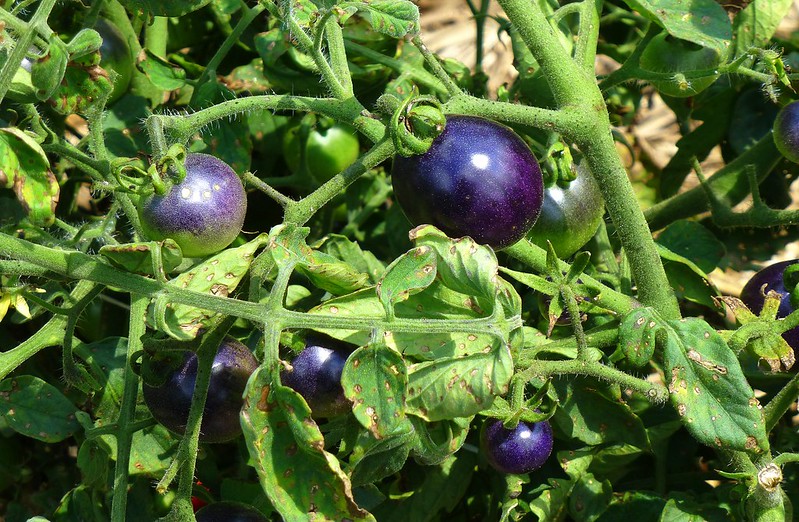
Ethical, Legal, and Social Issues
The use of genetic engineering has raised a number of ethical, legal, and social issues. Here are just a few:
- Who owns genetically modified organisms (such as bacteria)? Can such organisms be patented like inventions?
- Are genetically modified foods safe to eat? Might they have harmful effects on the people who consume them?
- Are genetically engineered crops safe for the environment? Might they harm other organisms — or even entire ecosystems?
- Who controls a person’s genetic information? What safeguards ensure that the information is kept private?
- How far should we go to ensure that children are free of mutations?
This example shows how complex such issues may be:
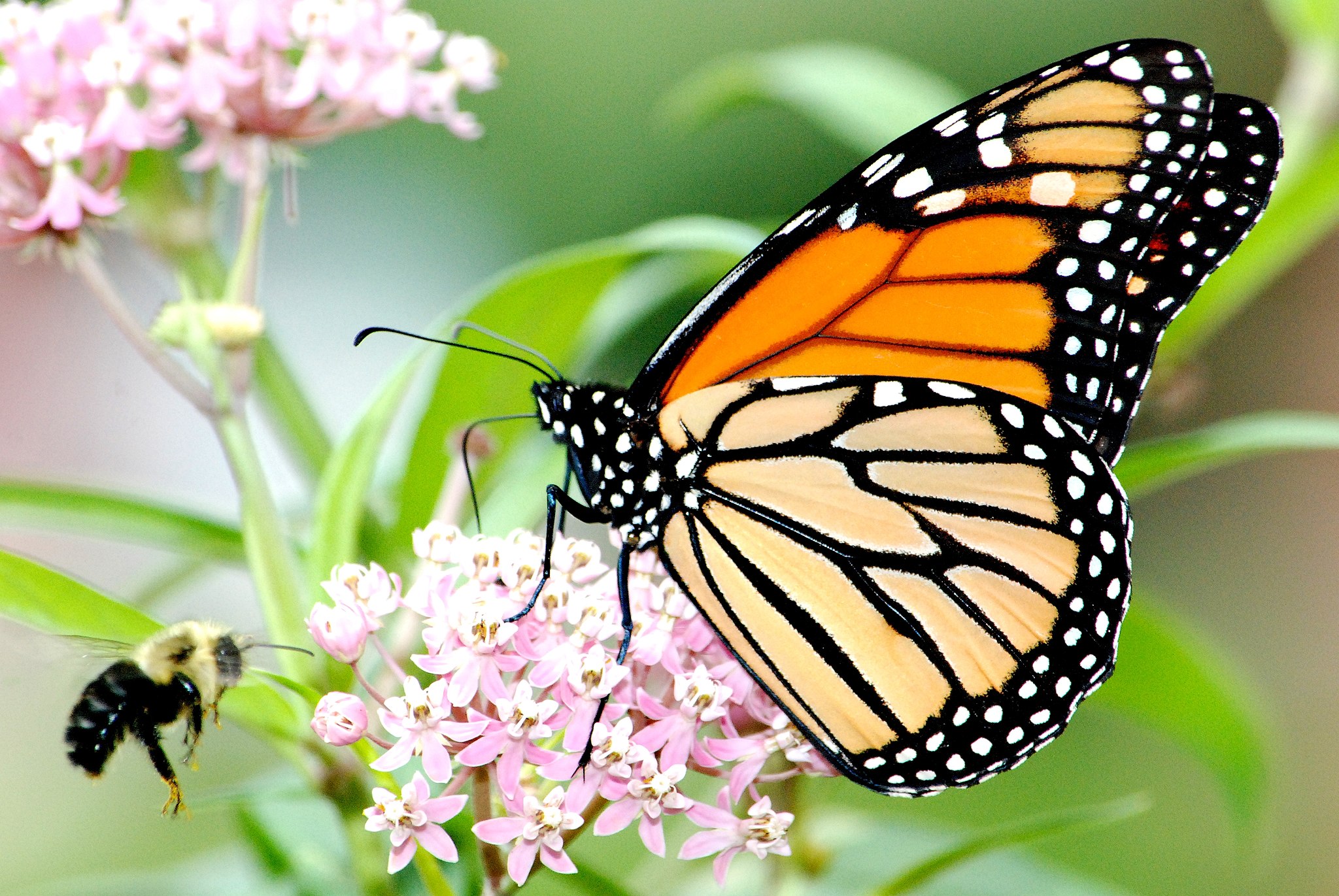
A strain of corn has been created with a gene that encodes a natural pesticide. On the positive side, the transgenic corn is not eaten by insects, so there is more corn for people to eat. The corn also doesn’t need to be sprayed with chemical pesticides, which can harm people and other living things. On the negative side, the transgenic corn has been shown to cross-pollinate nearby milkweed plants. Offspring of the cross-pollinated milkweed plants are now known to be toxic to monarch butterfly caterpillars that depend on them for food. Scientists are concerned that this may threaten the monarch species, as well as other species that normally eat monarchs.
As this example shows, the pros of genetic engineering may be obvious, but the cons may not be known until it is too late, and the damage has already been done. Unforeseen harm may be done to people, other species, and entire ecosystems. No doubt the ethical, legal, and social issues raised by genetic engineering will be debated for decades to come.
Feature: Reliable Sources
Genetically modified foods (or GM foods) are foods produced from genetically modified organisms. These are organisms that have had changes introduced into their DNA using methods of genetic engineering. Commercial sale of GM foods began in 1994, with a tomato that had delayed ripening. By 2015, three major crops grown in the U.S. were raised mainly from GM seeds, including field corn, soybeans, and cotton. Many other crops were also raised from GM seeds, ranging from a variety of vegetables to sugar beets. Other sources of GM foods in our diet include meats, eggs, and dairy products from animals that have eaten GM feed, as well as a plethora of food products that contain some form of soy or corn products, such as soybean oil, soybean flour, corn oil, corn starch, and corn syrup. A quick glance at the ingredients list of most processed foods shows that these products are added to many of the items in a typical American diet.
Most scientists think that GM foods are not necessarily any riskier to human health than conventional foods. Nonetheless, in many countries, including the U.S., GM foods are given more rigorous evaluations than conventional foods. For example, GM foods are assessed for toxicity, ability to cause allergic reactions, and stability of inserted genes. GM crops are also evaluated for possible environmental effects, such as outcrossing, which is the migration of genes from GM plants to conventional crops or wild plant species.
Despite the extra measures used to evaluate GM foods, there is a lot of public concern about them, including whether they are safe for human health, how they are labeled, and their environmental impacts. These concerns are based on a number of factors, such as the worrying belief that scientists are creating entirely new species, and a perceived lack of benefits to the consumer of GM foods. People may also doubt the validity of risk assessments, especially with regard to long-term effects. Lack of labeling of GM foods is also an issue because it denies consumers the choice of buying GM or conventional foods.
Find reliable online sources about GM foods. Look for information to answer the questions below. Make sure you evaluate the nature of the sources when you assess the reliability of the information they provide. Consider whether the sources may have a vested interest in one side of the issue or another. For example, major chemical companies might promote the use of seeds for crops that have been genetically engineered to be herbicide tolerant. Why? Because it boosts the use of the weed-killing chemical herbicides they produce and sell.
- In what ways are crops modified genetically? What traits are introduced, and what methods are used to introduce them?
- What are the main human safety questions about GM foods? How is the human safety of GM foods assessed?
- What are the main environmental concerns about GM crops? How is risk assessment for the environment performed?
- What are the major pros and cons of GM crops and foods? Who is most affected by these pros and cons? For example, for pros, do growers and marketeers receive most of the benefits, or do consumers also reap rewards?
5.16 Summary
- Genetic engineering is the use of technology to change the genetic makeup of living things for human purposes.
- Genetic engineering methods include gene cloning and the polymerase chain reaction. Gene cloning is the process of isolating and making copies of a DNA segment, such as a gene. The polymerase chain reaction makes many copies of a gene or other DNA segment.
- Genetic engineering can be used to transform bacteria so they are able to make human proteins, such as insulin. It can also be used to create transgenic crops, like crops that yield more food or resist insect pests.
- Genetic engineering has raised a number of ethical, legal, and social issues. For example, are genetically modified foods safe to eat? Who controls a person’s genetic information?
5.16 Review Questions
- Define genetic engineering
-
- What is recombinant DNA?
- Identify the steps of gene cloning.
- What is the purpose of the polymerase chain reaction?
- Make a flow chart outlining the steps involved in creating a transgenic crop.
- Explain how bacteria can be genetically engineered to produce a human protein.
- Identify an ethical, legal, or social issue raised bygenetic engineering. State your view on the issue, and develop a logical argument to support your view.
- Explain what primers are and what they do in PCR.
- The enzyme Taq polymerase was originally identified from bacteria that live in very hot environments, such as hotsprings. Why does this fact make Taq polymerase particularly useful in PCR reactions?
5.16 Explore More
https://www.youtube.com/watch?time_continue=1&v=3IsQ92KiBwM&feature=emb_logo
What is Genetic Engineering?, Eco-Wise Videos, 2015.
https://www.youtube.com/watch?time_continue=1&v=g_ZswrLFSdo&feature=emb_logo
Bringing biotechnology into the home: Cathal Garvey at TEDxDublin,
TEDx Talks, 2013.
Attributions
Figure 5.16.1
- Potato Plant by Lehava Maghar (Pikiwikisrael) on Wikimedia Commons via the PikiWiki - Israel free image collection project is used under a CC BY 2.5 (https://creativecommons.org/licenses/by/2.5/) license.
- Potato Plant Infected with Bacterial Ring Rot by William M. Brown Jr. on Wikimedia Commons via William M. Brown Jr., Bugwood.org via forestryimages.org is used under a CC BY 3.0 US (https://creativecommons.org/licenses/by/3.0/us/deed.en) license.
Figure 5.16.2
Polymerase_chain_reaction.svg by Enzoklop on Wikimedia Commons is used under a
CC BY-SA 3.0 (https://creativecommons.org/licenses/by-sa/3.0/deed.en) license.
Figure 5.16.3
Genetic Engineering in Medicine by CK-12 Foundation is used under a CC BY-NC 3.0 (https://creativecommons.org/licenses/by-nc/3.0/) license.
 ©CK-12 Foundation Licensed under
©CK-12 Foundation Licensed under ![]() • Terms of Use • Attribution
• Terms of Use • Attribution
Figure 5.16.4
Purple Tomato/Indigo Rose by F Delventhal on Flickr is used under a CC BY 2.0 (https://creativecommons.org/licenses/by/2.0/) license.
Figure 5.16.5
Monarch_Butterfly_and_Bumble_Bee_on_Swamp_Milkweed_(28960994212) by U.S. Fish and Wildlife Service on Wikimedia Commons is in the public domain (https://en.wikipedia.org/wiki/Public_domain).
References
Brainard, J/ CK-12 Foundation. (2016). Figure 4 Genetically engineering bacteria to produce a human protein. [digital image]. In CK-12 College Human Biology (Section 5.15) [online Flexbook]. CK12.org. https://www.ck12.org/book/ck-12-college-human-biology/section/5.15/
Eco-Wise Videos. (2015, March 28). What is genetic engineering? YouTube. https://www.youtube.com/watch?v=3IsQ92KiBwM&feature=youtu.be
TEDx Talks. (2013, October 22). Bringing biotechnology into the home: Cathal Garvey at TEDxDublin. YouTube. https://www.youtube.com/watch?v=g_ZswrLFSdo&feature=youtu.be
6.2 Genetic Variation: Review Questions and Answers
- Compare and contrast the significance of genetic variation at the individual and population levels. At the individual level, most human genetic variation is not very important biologically because it has no apparent adaptive significance. It neither enhances nor detracts from individual fitness. At the population level, genetic variation is crucial for evolution to occur. Genetically-based differences in fitness among individuals are the key to evolution by natural selection.
- Describe genetic variation within and between human populations on different continents. Any two randomly selected individuals differ in only about 0.1 per cent of their DNA base pairs. Of this genetic variation, about 90 per cent occurs between individuals within continental populations, and only about 10 per cent occurs between individuals from different continents.
- Explain why allele frequencies for the Duffy gene may be used as a genetic marker for African ancestry. Allele frequencies for the Duffy gene differ greatly between African (and African-derived) populations and other human populations. The allele for no Duffy antigen is very high in African populations (and relatively high in African Americans) but virtually absent from non-African populations. Therefore, allele frequencies for this gene may be used as a genetic marker for African ancestry.
- Identify factors that increase the level of genetic variation within populations. Factors that tend to increase genetic variation within a population include its age and size. You would expect an older, larger population to have more genetic variation. The older a population is, the longer it has been accumulating mutations. The larger a population is, the more people there are in which mutations can occur.
- Self-marking
- Discuss genetic evidence that supports the out-of-Africa hypothesis of modern human origins. Most studies of human genetic variation find greater genetic diversity in African than in non-African populations. This is consistent with the older age of the African population proposed by the out-of-Africa hypothesis. In addition, most of the genetic variation in non-African populations is a subset of the variation in African populations. This is consistent with the idea that part of the African population left Africa and migrated to other places in the Old World.
- What evidence suggests that modern humans interbred with archaic human populations after modern humans left Africa? Recent comparisons of modern human and archaic human DNA show that interbreeding occurred between their populations to differing degrees. The comparisons reveal greater admixture with archaic humans in modern European, Asian, and Oceanic populations than in modern African populations. Populations with the greatest admixture are those in Melanesia. About eight per cent of their DNA came from archaic Denisovans in East Asia.
- How do population size reductions and gene flow impact the genetic variation of populations?
- Describe the role of genetic variation in human disease. Going through a dramatic reduction in size reduces a population's genetic variation. A high rate of migration between populations may lead to gene flow, which decreases inter-population and increases intra-population variation. Gene flow primarily between nearby populations may contribute to the formation of clines in allele frequencies.
- Explain the reasons why variation in a DNA sequence can have no effect on the fitness of an individual. Variation in a DNA sequence can have no effect on fitness for a number of reasons. First, the variation may not occur in a coding or regulatory region of DNA, and therefore would not affect phenotype. Even if it did occur in a coding region of DNA, it may not affect phenotype because it might not change the amino acid sequence of the encoded protein or it might not affect how the protein functions even if it does change the amino acid sequence. If a genetic variation does not affect the phenotype, it cannot affect fitness. Finally, even if it does affect the phenotype, it does not necessarily mean that it affects fitness — i.e., it could be a neutral phenotypic change.
- Explain why migration between populations decreases inter-population genetic variation. How does this relate to the development of clines in allele frequency? Migration between populations decreases inter-population (between population) genetic variation because when individuals move between populations, their different alleles are included in the gene pool of the population that they move to. Interbreeding will often also occur between individuals who were originally from different populations. For these reasons, there will be fewer genetic differences between these populations if individuals are moving between them. Migration relates to the development of clines (i.e. gradual differences) in allele frequency because it causes gene flow between adjacent populations. If there was no gene flow, you would expect to see discrete areas of more significant differences in allele frequency.
- The amount of mixing of modern human DNA and archaic human DNA is an example of admixture.
6.3 Classifying Human Variation: Review Questions and Answers
- Name the 18th century taxonomist that classified virtually all known living things. Carl Linnaeus
- Describe the typological approach to classifying human variation. The typological approach to classifying human variation involves creating a typology, which is a system of discrete types, or categories, such as races. People are sorted into these categories based on a few readily observable phenotypic traits, such as skin colour, hair texture, facial features, and body build.
- Discuss why typological classifications of Homo sapiens are associated with racism. Typological classifications of Homo sapiens are associated with racism because unrelated and often negative traits are attributed to certain racial categories. This may lead to prejudice and discrimination against people based only on how they look. Race and racism are deeply ingrained in our history and culture.
- Why is the breeding population considered to be the most meaningful biological group? The breeding population is considered to be the most meaningful biological group because it is the unit of evolution. It includes people who have mated and produced offspring together for many generations. As a result members of the same breeding population should share many genetic traits.
- Explain why it is generally unrealistic to apply a populational approach to classifying the human species. It is generally unrealistic to apply a populational approach to classifying the human species because most human populations are not closed breeding populations. There has been and continues to be too much gene flow between populations.
- What does a clinal map show? A clinal map shows the geographic distribution of a trait or allele frequency.
- Explain how gene flow and natural selection can result in a gradual change in the frequency of a trait over geographic space. Gene flow tends to vary with distance between populations. Closer populations are likely to exchange genes more often than populations that are farther apart. Such differences in gene flow could produce a gradual change in the frequency of a trait over geographic space. An environmental stressor may vary gradually over space, creating a geographic continuum of selective pressure. Variation in selective pressure may produce corresponding variation in a trait over space.
- Most human traits vary on a continuum. Explain why this presents a problem for the typological classification approach. Since most human traits vary on a continuum, it is difficult to create a sharp dividing line between categories of people, as is done in the typological classification approach.
- Self-marking
6.4 Human Responses to Environmental Stress: Review Questions and Answers
- List four different types of responses that humans may make to cope with environmental stress. Four different types of responses that humans may make to cope with environmental stress are adaptation, developmental adjustment, acclimatization, and cultural responses.
- Define adaptation. An adaptation is a genetically based trait that has evolved by natural selection because it helps living things survive and reproduce in a given environment.
- Self-marking
- Explain how natural selection may have resulted in most human populations having people who can and people who cannot taste PTC. PTC is an artificial, harmless, bitter-tasting compound similar to toxic bitter compounds found in plants. The ability to taste PTC may have been selected for because it helped people identify bitter-tasting toxic plants so they could avoid eating them. Nontasters are hypothesized to be able to taste a different, yet-to-be-identified bitter compound. The gene for PTC tasting has two alleles, T for tasting PTC and t for nontasting PTC (or for tasting some other bitter compound). People who have both alleles (Tt) should be able to taste the widest range of bitter compounds, so they would be the most fit and favored by natural selection. This would result in both alleles, as well as both taster and nontaster phenotypes, being maintained in populations.
- What is a developmental adjustment? A developmental adjustment is a type of nongenetic response to environmental stress. It consists of a phenotypic change that occurs during development in infancy or childhood and that may persist into adulthood. This type of change may be irreversible.
- Define phenotypic plasticity. Phenotypic plasticity is the ability to change the phenotype in response to changes in the environment, allowing individuals to respond to changes that occur during their lifetime.
- Explain why phenotypic plasticity may be particularly important in a species with a long generation time. Phenotypic plasticity may be particularly important in a species with a long generation time because in such species the evolution of genetic adaptations may occur too slowly to keep up with changing environmental stresses.
- Why may stunting of growth occur in children who have an inadequate diet? Why is stunting preferable to the alternative? Stunting of growth may occur in children who have an inadequate diet because they do not take in enough nutrients and calories to fuel both growth and basic metabolic processes. The nutrients and calories are shunted away from growth and toward maintaining life, allowing children to survive at the expense of increased body size. The alternative would be to use nutrients and calories for growth at the expense of life processes, which could possibly result in death.
- What is acclimatization? Acclimatization is the development of reversible changes to environmental stress that generally occur over a relatively short period of time. When the stress is no longer present, the acclimatized state declines, and the body returns to its normal baseline state.
- How does acclimatization to heat come about, and what are two physiological changes that occur in heat acclimatization? Acclimatization to heat occurs when one gradually works out harder and longer at high temperatures. It may take up to two weeks to attain maximum heat acclimatization. Two physiological changes that occur in heat acclimatization are increased sweat output and earlier onset of sweat production. These changes help the body lose heat through the evaporation of sweat, which is called evaporative cooling.
- Give an example of a cultural response to heat stress. An example of a cultural response to heat stress is the use of air conditioning to maintain a cool environment.
- Which is more likely to be reversible — a change due to acclimatization, or a change due to developmental adjustment? Explain your answer. A change due to acclimatization is more likely to be reversible than a change due to developmental adjustment. This is because in acclimatization, the phenotype reverts back to the baseline state once the stressor is gone. In developmental adjustment, the changes that occur during development may or may not be permanent, depending on the circumstances.
6.5 Variation in Blood Types: Review Questions and Answers
- Define blood type and blood group system. Blood type is a genetic characteristic associated with the presence or absence of antigens on the surface of the red blood cell. Blood group system refers to all of the genes, alleles, and possible genotypes and phenotypes that exist for a particular set of blood type antigens.
- Explain the relationship between antigens and antibodies. Antigens are molecules that the immune system identifies as either self or nonself. If antigens are identified as nonself, the immune system responds by forming antibodies that are specific to the nonself antigens. Antibodies are large, Y-shaped proteins produced by the immune system that recognize and bind to nonself antigens. They fit together like a lock and key. When antibodies bind to antigens, it marks them for destruction by other immune system cells.
- Identify the alleles, genotypes, and phenotypes in the ABO blood group system. The ABO blood group system is controlled by one gene with three common alleles, represented by A, B, and O. There are six possible genotypes with three alleles: AA, AB, BB, BO, AO, and OO. Because A and B are codominant and both are dominant to O, there are four possible phenotypes: type A (AA, AO), type B (BB, BO), type AB (AB), and type O (OO).
- Discuss the medical significance of the ABO blood group system. The ABO blood group system is the most important blood group system in blood transfusions. If red blood cells containing a particular ABO antigen are transfused into a person who lacks that antigen, the person’s immune system will recognize the antigen on the red blood cells as nonself and attack them, causing agglutination.
- Compare the relative worldwide frequencies of the three ABO alleles. The ABO allele for antigen B is the least common worldwide. The allele for antigen A is more common than the allele for antigen B but less common than the allele for antigen O, which is the most common ABO allele.
- Give examples of how different ABO blood types vary in their susceptibility to diseases. Answers may vary. Sample answer: People with type O blood may be more susceptible to cholera, plague, and gastrointestinal ulcers; but they may be less susceptible to malaria. People with type A blood may be more susceptible to smallpox and certain cancers.
- Describe the Rhesus blood group system. The Rhesus blood group system is controlled by two linked genes with many alleles on chromosome 1. There are five main Rhesus antigens: D, C, c, E, and e. The major antigen is D, which is either present (Rh+) or absent (Rh-).
- Relate Rhesus blood groups to blood transfusions. People with Rh+ blood can safely receive a blood transfusion of Rh+ or Rh- blood. People with Rh- blood can safely receive a blood transfusion only of Rh- blood.
- What causes hemolytic disease of the newborn? Hemolytic disease of the newborn is caused by an Rh- mother producing antibodies to the D antigen in the blood of an Rh+ fetus. The maternal antibodies may destroy fetal red blood cells, causing anemia.
- Describe how toxoplasmosis may explain the persistence of the Rh- blood type in human populations. Toxoplasmosis is a common parasitic disease that may have lasting neurological effects such as delayed reaction times, which can lead to an increase in traffic accidents and possibly other accidental injuries. People who are heterozygous for the Rhesus D antigen appear to be less likely to develop these lasting neurological effects, so they might be selected for by natural selection. If so, this could explain why both Rh+ and Rh- phenotypes persist in human populations.
- A woman is blood type O and Rh-, and her husband is blood type AB and Rh+. Answer the following questions about this couple and their offspring.
- What are the possible genotypes of their offspring in terms of ABO blood group? AO or BO
- What are the possible phenotypes of their offspring in terms of ABO blood group? A or B
- Can the woman donate blood to her husband? Explain your answer. Yes, because O is the universal donor since it has no A or B antigens, and in any case, AB is the universal recipient since it has both antigens. Also, since she is Rh-, she can donate to an Rh+ person.
- Can the man donate blood to his wife? Explain your answer. No, because he is AB which contains the antigens for both A and B, and since she is type O she has antibodies against A and B. Also, because he is Rh+ and she is Rh-, her body will create antibodies against his D antigen as well.
- Type O blood is characterized by the presence of O antigens — explain why this statement is false. This statement is false because the O allele actually codes for the absence of an antigen, which means there is no "O" allele, just the absence of an antigen.
- Explain why newborn hemolytic disease may be more likely to occur in a second pregnancy than in a first Hemolytic disease of the newborn may be more likely to occur in a second pregnancy than in a first, because the generation of anti-D antibodies usually requires exposure to Rh+ blood in an Rh- person. This exposure may happen during an Rh- mother’s first birth to an Rh+ baby, and then in a subsequent pregnancy, the fetus is at risk of HDN because the anti-D antibodies are already present.
6.6 Human Responses to High Altitude: Review Questions and Answers
- Define hypoxia. Hypoxia is a lack of oxygen.
- Why does hypoxia occur at high altitudes? Hypoxia occurs at high altitudes because the atmosphere is less dense at high altitudes, so there is less oxygen in each breath and lower air pressure to move air from the lungs across cell membranes into the blood.
- Describe the body’s immediate response to hypoxia at high altitude. The body’s immediate response to hypoxia at high altitude is an increase in the rate of breathing (hyperventilation) and elevation of the heart rate.
- Self-marking
- What is high altitude sickness, and what are its symptoms? High altitude sickness is a collection of symptoms that occur in response to the hypoxia at high altitude in a person who is not acclimated or adapted to this stress. It includes symptoms such as fatigue, shortness of breath, loss of appetite, headache, dizziness, and vomiting.
- What changes occur during acclimatization to high altitude? During acclimatization to high altitude, additional red blood cells are produced, capillaries become more numerous in muscle tissues, the lungs increase slightly in size, and there is a small increase in the size of the right ventricle of the heart, which is the heart chamber that pumps blood to the lungs.
- Where would you expect to find populations with genetic adaptations to high altitude? You would expect to find populations with genetic adaptations to high altitude in high altitude areas above 2,500 metres where people have been living continuously for thousands of years, including the Andes Mountains, Himalaya Mountains, Tibetan Plateau, and Ethiopian Highlands.
- Discuss variation in adaptations to high altitude in different high altitude regions. Different high altitude populations have evolved different adaptations to the same hypoxic stress. Tibetan highlanders, for example, have a faster rate of breathing and large arteries, whereas Peruvian highlanders have larger red blood cells and a greater concentration of the oxygen-carrying protein hemoglobin.
- Why do you think that adaptations to living at high altitude are different in different regions of the world?
- Using human responses to high altitude as an example, explain the difference between acclimatization and adaptation.
- Why are most humans not well-adapted to living at high altitudes?
- If a person that normally lives at sea level wants to climb a very high mountain, do you think it is better for them to move to higher elevations gradually or more rapidly? Explain your answer.
6.7 Human Responses to Extreme Climates: Review Questions and Answers
- Compare and contrast hypothermia and hyperthermia. Both hypothermia and hyperthermia are dangerous responses to temperature extremes. Hypothermia is a decrease in core body temperature that occurs in the cold. Hyperthermia is an in increase in core body temperature that occurs in the heat.
- State Bergmann’s and Allen’s rules. Bergmann’s rule states that populations or species have larger body size in colder climates, and vice versa. Allen’s rule states that populations or species have longer extremities in warmer environments, and vice versa.
- How do the Maasai and Inuit match the predictions based on Bergmann’s and Allen’s rules? The Maasai, who live in the tropics, have long, linear bodies with very long legs, so they have a heat-adapted body build as predicted by Bergmann’s and Allen’s rules. The Inuit, who live in the Arctic, have stocky bodies with relatively short limbs, so they have a cold-adapted body build as predicted by Bergmann’s and Allen’s rules.
- Explain how sweating cools the body. Sweating coats the skin with moisture. When the moisture evaporates, it requires heat. The heat comes from the surface of the body, which cools the body.
- What is the heat index? The heat index is a number that combines air temperature and relative humidity to indicate how hot the air feels due to the humidity.
- Relate the heat index to evaporative cooling of the body. When the heat index is high for a given air temperature, it means that the relative humidity is high. With high humidity, sweat will not evaporate readily from the body, and evaporative cooling will not be very effective.
- Identify three heat-related illnesses, from least to most serious. Three heat-related illnesses from least to most serious are heat cramps, heat exhaustion, and heat stroke.
- How does heat acclimatization occur? Heat acclimatization occurs by gradually increasing the duration and intensity of working out at high temperatures. Maximum acclimatization may take up to 14 days. Changes that occur with acclimatization include greater sweat production, decreased salt concentration in sweat, earlier onset of sweating, and vasodilation near the skin so blood can bring heat to the surface of the body from the body core.
- State two major ways the human body can respond to the cold, and give an example of each. Two major ways the body can respond to cold are by generating more heat (for example, by shivering) and by conserving more body heat (for example, by vasoconstriction).
- Explain how and why the hunting response occurs. The hunting response occurs as a response to cold. It involves alternating vasoconstriction and vasodilation in the extremities. This helps conserve body heat while preventing cold injury to the extremities.
- Define basal metabolic rate. Basal metabolic rate is the amount of energy a person needs to keep the body functioning at rest.
- How does a high-fat diet help prevent hypothermia? A high fat diet helps prevent hypothermia by increasing the basal metabolic rate so the body generates more heat.
- Explain why frostbite most commonly occurs in the extremities, such as the fingers and toes. Frostbite most commonly occurs in the extremities, such as the fingers and toes, because one of the body’s responses to cold is vasoconstriction, which moves blood away from the extremities to protect the internal organs in the body’s core. This leaves the extremities more vulnerable to cold and frostbite.
6.8 Nutritional Adaptation: Review Questions and Answers
- Self-marking
- Distinguish between the terms lactose and lactase. Lactose is a disaccharide found in milk. Lactase is an enzyme that is needed to digest lactose by breaking it down into its two component sugars.
- What is lactose intolerance, and what percentage of all people have it? Lactose intolerance is the inability to synthesize lactase and digest lactose after early childhood, leading to symptoms such as bloating and diarrhea if milk is consumed. Lactose intolerance occurs in about 60 per cent of all people.
- Where and why did lactase persistence evolve? Lactase persistence evolved in populations that herded milking animals for thousands of years. People who were able to synthesize lactase and digest lactose throughout life were strongly favored by natural selection.
- What is the thrifty gene hypothesis? The thrifty gene hypothesis posits that “thrifty genes” were selected for because they allowed people to use calories efficiently and store body fat when food was plentiful so they had a reserve to use when food was scarce. Thrifty genes become detrimental and lead to obesity and diabetes when food is plentiful all of the time.
- How well is the thrifty gene hypothesis supported by evidence? Several assumptions underlying the thrifty gene hypothesis have been called into question, and genetic research has been unable to actually identify thrifty genes.
- Describe an alternative hypothesis to the thrifty gene hypothesis. Several alternative hypotheses to the thrifty gene hypothesis have been proposed, so answers may vary. Sample answer: The drifty gene hypothesis explains variation in the tendency to become obese and develop diabetes by genetic drift on neutral genes.
- Do you think that a lack of exposure to dairy products might affect a person’s lactase level? Why or why not? Answers may vary. Sample answer: I think that a lack of exposure to dairy products might affect a person’s lactase level, because production of lactase may not just depend on genes—it also may depend on exposure to lactose.
- Describe an experiment you would want to do or data you would want to analyze that would help to test the thrifty phenotype hypothesis. Remember, you are studying people, so be sure it is ethical! Discuss possible confounding factors that you should control for, or that might affect the interpretation of your results. Answers will vary. Sample answer: To test the thrifty phenotype hypothesis, I would examine data on the rates of type II diabetes in adulthood for people whose mother was pregnant with them during times and regions of famine. Times of famine might have additional factors, such as types of food available, extreme maternal stress, or other environmental conditions that could also affect the development of diabetes, other than overall lack of food. Also, you may not be able to determine whether an individual’s mother personally experienced famine, or to what extent. It may be completely unknown or you may need to rely on self-reporting of events that happened many years ago.
- Explain the relationship between insulin, blood glucose, and type II diabetes. Diabetes is a disease that occurs when there are problems with the pancreatic hormone insulin, which normally helps cells take up glucose from the blood and controls blood glucose levels. In type II diabetes, body cells become relatively resistant to insulin, leading to high blood glucose.
Chapter 6 Case Study Conclusion: Review Questions and Answers
- Explain why an evolutionarily older population is likely to have more genetic variation than a similarly-sized younger population. The older a population is, the longer it has been accumulating mutations, so therefore an older population is likely to have more genetic variation than a similarly-sized younger population.
- The genetic difference between any two people on Earth is only about 0.1 per cent. Based on our evolutionary history, describe one reason why humans are relatively homogeneous genetically. Answers may vary, but can include: modern humans’ relatively recent evolution (less than a quarter million years ago), which is a relatively short period of time for mutations to accumulate; the relatively small human population size (possibly around 10,000 adults) in the past, which also limited genetic variability.
- What aspect(s) of human skin colour are due to adaptation? Be sure to define adaptation in your answer. What aspect(s) of human skin colour are due to acclimatization? Be sure to define acclimatization in your answer. Adaptation is a genetic change that occurs through natural selection. Adaptations that influence skin colour in humans include the type and amount of melanin produced by the skin. Acclimatization is a temporary physiological change in response to environmental stress. The ability of the skin to become darker, or tan, when exposed to UV radiation is a type of acclimatization that influences skin colour.
- For each of the following human responses to the environment, list whether it can be best described as an example of adaptation, acclimatization, or developmental adjustment:
- Reduction in height due to lack of food in childhood Developmental adjustment.
- Resistance to malaria Adaptation.
- Shivering in the cold Acclimatization.
- Changes in body size and dimensions to better tolerate heat or cold Adaptation.
- Give an example of a human response to environmental stress that involves changes in behavior, instead of changes in physiology. Answers will vary but may include: the creation of shelters, clothing, and technology such as air conditioning.
- What are two types of environmental stresses that caused genetic changes related to hemoglobin in some populations of humans? Malaria and high altitude
- The ability of an organism to change their phenotype in response to the environment is called phenotypic plasticity.
- List three natural selection pressures that differ geographically across the world and contributed to the evolution of human genetic variation in different regions. Answers may vary. Sample answer: Altitude; climate; UV levels; presence of endemic malaria.
- You may have noticed that when a sudden hot day occurs during a cool period, it can feel even more uncomfortable than higher temperatures during a hot period — even with the same humidity levels. Using what you learned in this chapter, explain why you think that happens. Answers may vary. Sample answer: I think that a sudden hot day during a cool period feels particularly uncomfortable because your body has not yet acclimated to the heat. Full heat acclimatization can take weeks. During longer periods of heat, your body acclimatizes physiologically to cool you more effectively.
- Out of all mammals, why are humans the only ones that evolved lactase persistence? Humans are the only mammals that evolved lactase persistence, because humans are the only mammals to consume milk in adulthood, due to our domestication of other species for food. It is energetically costly to produce an enzyme that is not needed, so that is probably why other mammals stop making it after the weaning period.
- If the Inuit people who live in the Arctic were not able to get enough vitamin D from their diet, what do you think might happen to their skin colour over a long period of time? Explain your answer. Answers may vary. Sample answer: I think that if the Inuit people were not able to get enough vitamin D from their diet, over a long period of time their skin colour may become lighter. This is because vitamin D, which is important for health, can be synthesized by the skin from UV light exposure. UV light penetrates lighter skin better than darker skin, so people with lighter skin will produce vitamin D more easily. In the absence of sufficient vitamin D in the diet in the Arctic where UV levels are low, people with lighter skin may have an evolutionary advantage due to better health. Over a long period of time, that may lead to the population as a whole having lighter skin.
- Explain why malaria has been such a strong force of natural selection on human populations. Answers may vary. Sample answer: Malaria has been such a strong force of natural selection on human populations for several reasons. First, it is widespread in areas consistently inhabited by large numbers of humans, particularly after the advent of agriculture, because of the nature of malaria life cycle. Second, malaria has been around for a long period of human history, and natural selection causes evolutionary changes only over many generations. Third, malaria is often deadly, particularly to young children and infants, and can cause miscarriages and stillbirths. Because it affects the reproductive rate in this manner, malaria is a strong force of natural selection, dramatically reducing the fitness of individuals that are susceptible to it.
- Give one example of “heterozygote advantage” (i.e. when the heterozygous genotype has higher relative fitness than the dominant or recessive homozygous genotype) in humans. Answers will vary but may include: hemoglobin adaptations in response to malaria; the Rhesus D antigen; the taster/nontaster alleles.
- What is one way in which humans have evolved genetic adaptations in response to their food sources? Answers will vary but may include: lactose persistence; taster genes; the ability to survive on lower amounts of food.
- Do you think adaptation to high altitude evolved once or several times? Explain your reasoning. Answers may vary. Sample answer: Adaptations to high altitude probably evolved independently several times because the specific adaptations are different in different regions. If it had evolved once, you would expect the adaptation to be the same in different populations.
Image shows an adult and child sitting together.
Created by: CK-12/Adapted by Christine Miller
Yum!

It glistens with fat, from the cheese to the fries. Both cheese and fries are typically high-fat foods, so this meal is definitely not recommended if you are following a low-fat diet. We need some fats in our diet for good health, but too much of a good thing can be harmful to our health, no matter how delicious it tastes. What are fats? And why do we have such a love-hate relationship with them? Read on to find out.
Lipids and Fatty Acids
Fats are actually a type of lipid. Lipids are a major class of biochemical compounds that includes oils, as well as fats. Among other things, organisms use lipids to store energy.
Lipid molecules consist mainly of repeating units called fatty acids. There are two types of fatty acids: saturated fatty acids and unsaturated fatty acids. Both types consist mainly of simple chains of carbon atoms bonded to one another and to hydrogen atoms. The two types of fatty acids differ in how many hydrogen atoms they contain and the number of bonds between carbon atoms.
3.5 Cultural Connection: Fats in Tanning
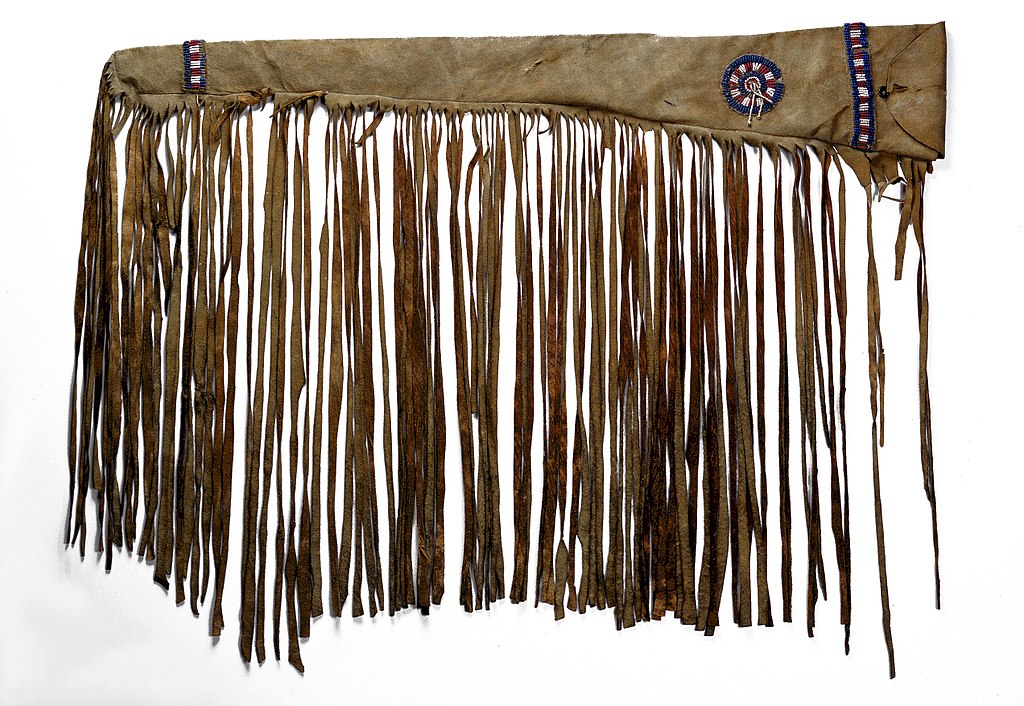
Ancient civilizations all over the world have used fats in the hide tanning process. If raw hides (animal skins) aren't tanned, they get very brittle and can breakdown. Tanning results in a hide that is soft, flexible, and resists decay.
One method of tanning is called "brain tanning". It's name is quite self-explanatory — a mixture of boiled animal brains is used to tan a hide. A type of fat in the brain, called lecithin, is a natural tanning agent. Once the hide has been rubbed with the brain mixture, it is smoked and then it is ready for use!
Brain tanning is preferred in many cultures because it creates hides which are waterproof and it doesn't create environmentally harmful byproducts.
Saturated Fatty Acids
In saturated fatty acids, carbon atoms are bonded to as many hydrogen atoms as possible. All the carbon-to-carbon atoms share just single bonds between them. This causes the molecules to form straight chains, as shown in the figure below. The straight chains can be packed together very tightly, allowing them to store energy in a compact form. Saturated fatty acids have relatively high melting points, which explains why they are solids at room temperature. Animals use saturated fatty acids to store energy. Some dietary examples of saturated fats include butter and lard.
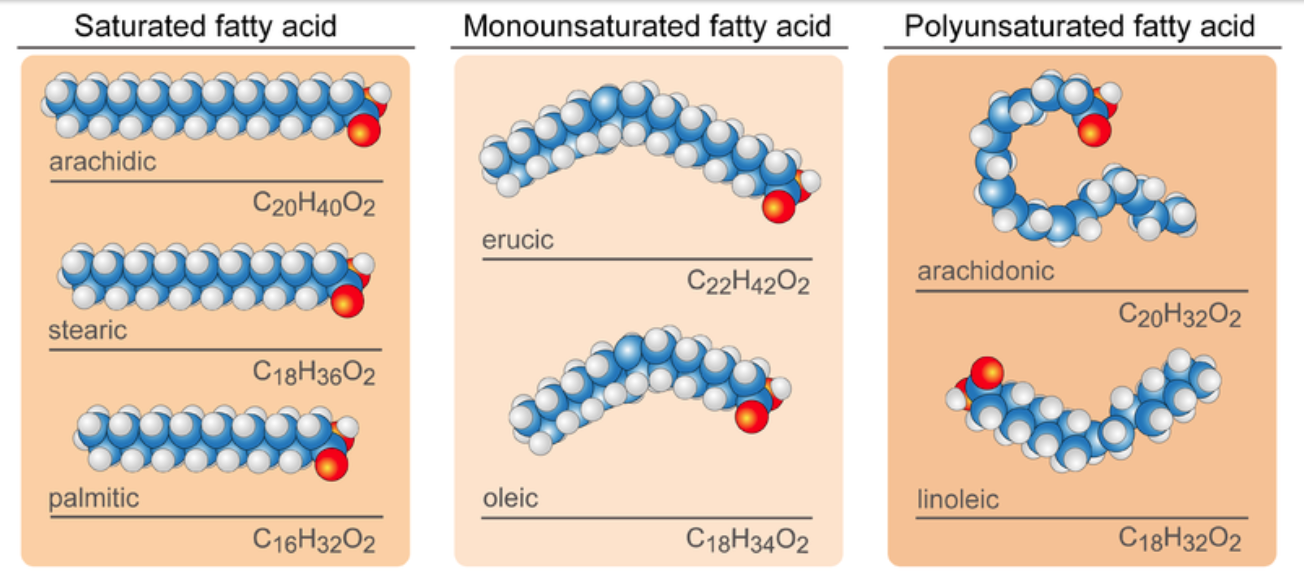
Unsaturated Fatty Acids
In unsaturated fatty acids, some carbon atoms are not bonded to as many hydrogen atoms as possible. Instead, they form double or even triple bonds with other carbon atoms. This causes the chains to bend (see Figure 3.5.3). The bent chains cannot be packed together very tightly. Unsaturated fatty acids have relatively low melting points, which explains why they are liquids at room temperature. Plants use unsaturated fatty acids to store energy.
Monounsaturated fatty acids contain one less hydrogen atom than the same-length saturated fatty acid chain. Monounsaturated fatty acids are liquids at room temperature, but start to solidify at refrigerator temperatures. Good food sources of monounsaturated fats include olive oils, peanut oils, and avocados.
Polyunsaturated fatty acids contain at least two fewer hydrogen atoms than the same-length saturated fatty acid chain. Polyunsaturated fatty acids are liquids at room temperature and remain in the liquid state in the refrigerator. Good food sources of polyunsaturated fats include safflower oils, soybean oils, and many nuts and seeds.
Types of Lipids
Lipids may consist of fatty acids alone, or they may contain other chemical components, as well. For example, some lipids contain alcohol or phosphate groups. Types of lipids include triglycerides, phospholipids, and steroids. Each type has different functions in living things.
Triglycerides
Triglycerides are formed by combining a molecule of glycerol with three fatty acid molecules, as shown below. Glycerol (also called glycerine) is a simple compound known as a sugar alcohol. It is a colourless, odorless liquid that is sweet tasting and nontoxic. Triglycerides are the main constituent of body fat in humans and other animals. They are also found in fats derived from plants. There are many different types of triglycerides, with the main division being between those that contain saturated fatty acids and those that contain unsaturated fatty acids.

In the human bloodstream, triglycerides play an important role in metabolism as energy sources and transporters of dietary fat. They contain more than twice as much energy as carbohydrates, the other major source of energy in the diet. When you eat, your body converts any calories it doesn't need to use right away into triglycerides, which are stored in your fat cells. When you need energy between meals, hormones trigger the release of some of these stored triglycerides back into the bloodstream.
Phospholipids
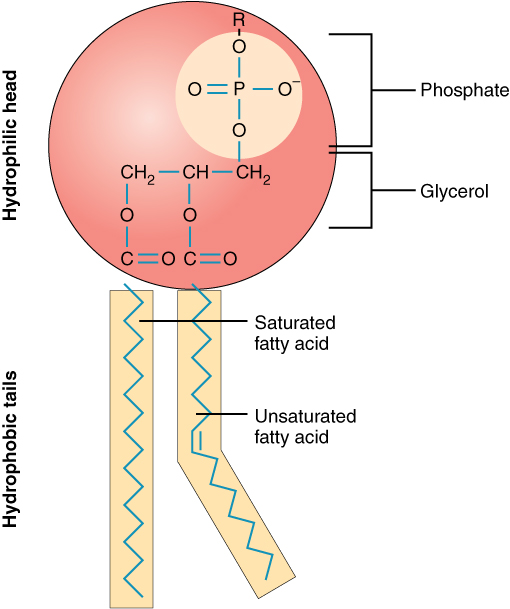
Phospholipids are a major component of the cell membranes of all living things. Each phospholipid molecule has a "tail" consisting of two long fatty acids, and a "head" consisting of a phosphate group and glycerol molecule (see Figure 3.5.5). The phosphate group is a small, negatively-charged molecule causing it to be hydrophilic, or attracted to water. The fatty acid tail of the phospholipid is hydrophobic, or repelled by water. These properties allow phospholipids to form a two-layered cell membrane, which is also called a bilayer.
As shown in Figure 3.5.6, a phospholipid bilayer forms when many phospholipid molecules line up tail to tail, forming an inner and outer surface of hydrophilic heads. The hydrophyilic heads point toward both the watery extracellular space and the watery inside space (lumen) of the cell. The hydrophobic fatty acids are nestled in the inner space of the bilayer.
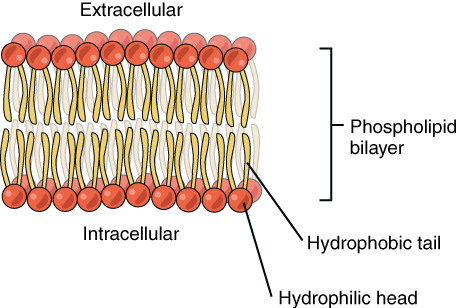
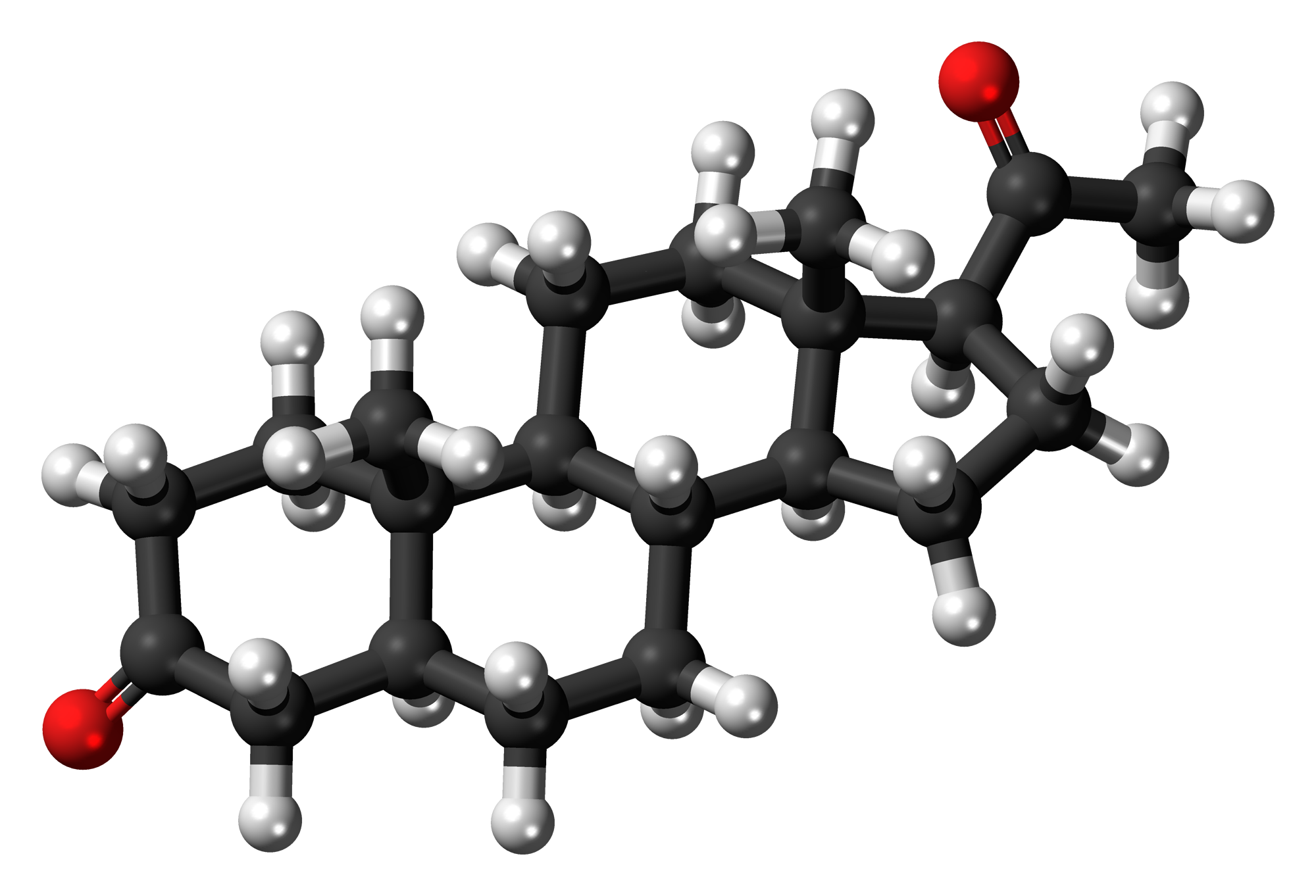
Steroids
Steroids are lipids with a ring structure. Each steroid has a core of 17 carbon atoms, which are arranged in four rings of five or six carbons each (pictured in Figure 3.5.7). Steroids vary by the other components attached to this four-ring core. Hundreds of steroids are found in plants, animals, and fungi, but most steroids have one of just two principal biological functions. Some steroids (such as cholesterol) are important components of cell membranes, while many other steroids are hormones, which are messenger molecules. In humans, steroid hormones include cortisone — a fight-or-flight hormone — and the sex hormones estrogen, progesterone and testosterone.
Feature: My Human Body
During a routine checkup with your family doctor, your blood was collected for a lipid profile. The results are back, and your triglyceride level is 180 mg/dL. Your doctor says this is a little high. A blood triglyceride level of 150 mg/dL or lower is considered normal. Higher levels of triglycerides in the blood have been linked to an increased risk of atherosclerosis, heart disease, and stroke.
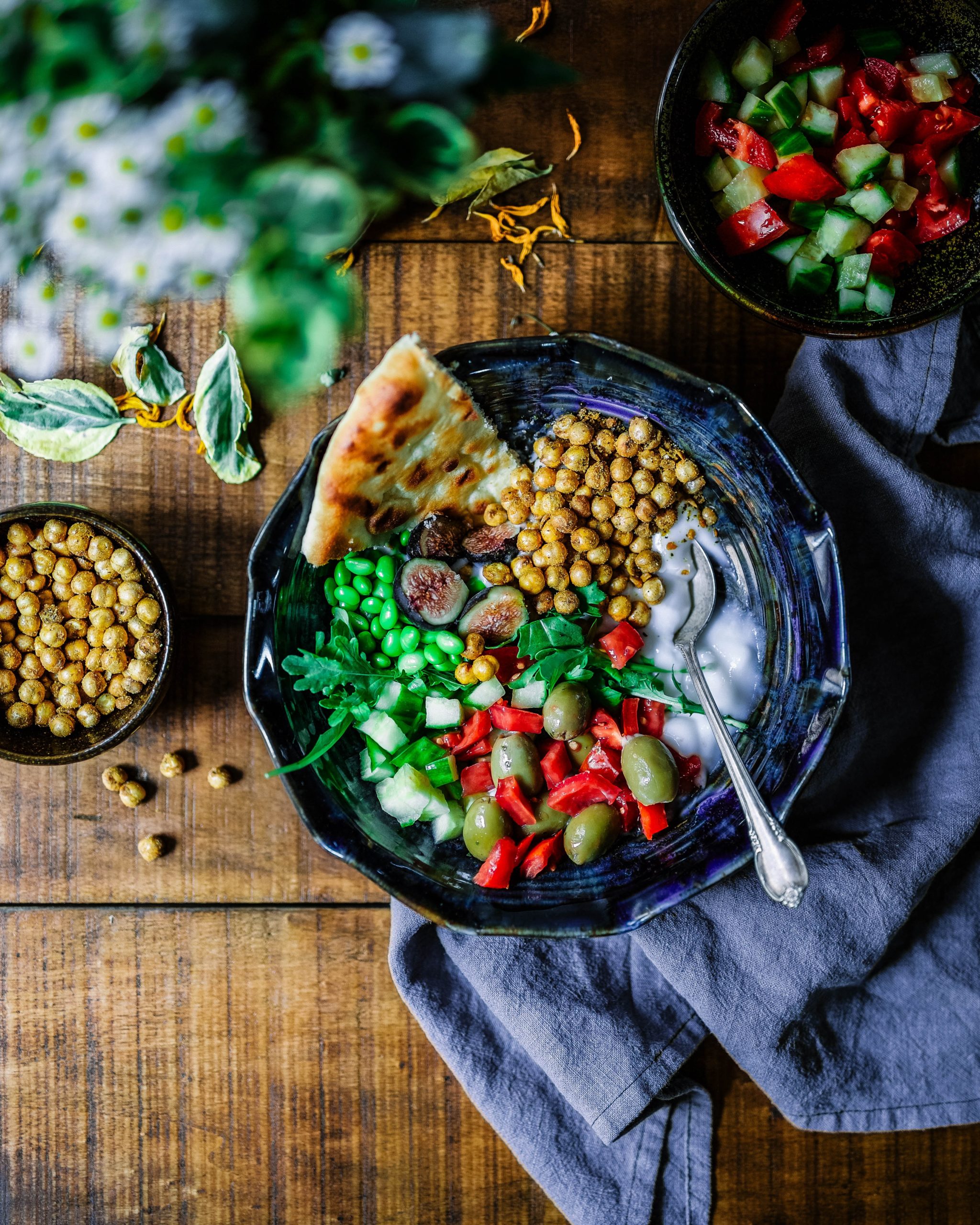
If a blood test reveals that you have high triglycerides, the levels can be lowered through healthy lifestyle choices and/or prescription medications. Healthy lifestyle choices to control triglyceride levels include:
- Weight loss: If you are overweight, losing even 5 or 10 pounds (about 2.2 to 4.5 kg) may help lower your triglyceride level.
- Calorie reduction: Extra calories are converted to triglycerides and stored as fat, so reducing your calories should also reduce your triglyceride level.
- Reduction in sugars and refined foods: Simple carbohydrates, such as sugars and foods made with white flour, can increase triglyceride levels.
- Healthier fats: Trade saturated fats found in animal foods for healthier unsaturated fats found in plants and oily fish. For example, substitute olive oil for butter and salmon for red meat.
- Cut back on alcohol: Alcohol is high in calories and sugar. It has a strong effect on triglyceride levels.
- Regular exercise: Aim for at least 30 minutes of physical activity on most or all days of the week.
If healthy lifestyle changes aren't enough to bring down high triglyceride levels, drugs prescribed by your doctor are likely to help.
3.5 Summary
- Lipids are a major class of biochemical compounds that includes oils and fats. Organisms use lipids for storing energy and for making cell membranes and hormones, which are chemical messengers.
- Lipid molecules consist mainly of repeating units called fatty acids. Depending on the proportion of hydrogen atoms they contain, fatty acids may be saturated or unsaturated. Animals store fat as saturated fatty acids, while plants store fat as unsaturated fatty acids.
- Types of lipids include triglycerides, phospholipids, and steroids. Each type consists of fatty acids and certain other molecules. Each also has different functions.
- Triglycerides contain glycerol (an alcohol), in addition to fatty acids. Humans and other animals store fat as triglycerides in fat cells.
- In addition to fatty acids, phospholipids contain phosphate and glycerol. They are the main component of cell membranes in all living things.
- Steroids are lipids with a four-ring structure. Some steroids (such as cholesterol) are important components of cell membranes. Many other steroids are hormones. An example of a human hormone is cortisone, which is the fight-or-flight hormone.
3.5 Review Questions
- What are lipids?
-
- Compare and contrast saturated and unsaturated fatty acids.
- Identify three major types of lipids. Describe differences in their structures.
- How do triglycerides play an important role in human metabolism?
- Explain how phospholipids form cell membranes.
- What is cholesterol? What is its major function?
- Give three examples of steroid hormones in humans.
- Which type of fatty acid do you think is predominant in the cheeseburger and fries shown above? Explain your answer.
- Which type of fat would be the most likely to stay liquid in colder temperatures: bacon fat, olive oil, or soybean oil? Explain your answer.
- Why do you think that the shape of the different types of fatty acid molecules affects how easily they solidify? Can you think of an analogy for this?
- High cholesterol levels in the bloodstream can cause negative health effects. Explain why we wouldn’t want to get rid of all of the cholesterol in our bodies.
3.5 Explore More
https://www.youtube.com/watch?v=zqSoyaDu4b0&feature=emb_logo
Cortisone and Healing - An overview of the science, by Sportology and OrthoCarolina, 2015
https://www.youtube.com/watch?v=QhUrc4BnPgg&feature=emb_logo
What is fat? - George Zaidan, TED-Ed, 2013
Attributions
Figure 3.5.1
cheeseburger by kayleigh harrington on Unsplash is used under the Unsplash License (https://unsplash.com/license).
Figure 3.5.2
Buffalo_Hide_Beaded_Guncase by Unknown onWikimedia Commons, is used under the Missouri History Museum's MHS Open Access Policy. Image is released into the public domain (https://en.wikipedia.org/wiki/Public_domain).
Figure 3.5.3
Fatty acids by CK-12 Foundation is used under a CC BY-NC 3.0 (https://creativecommons.org/licenses/by-nc/3.0/) license.
Figure 3.5.4
Fat_triglyceride_shorthand_formula by Wolfgang Schaefer on Wikimedia Commons, is released into the public domain (https://en.wikipedia.org/wiki/Public_domain).
Figure 3.5.5
Phospholipid_Structure by OpenStax on Wikimedia Commons, is used under a CC BY 4.0 (https://creativecommons.org/licenses/by/4.0) license.
Figure 3.5.6
Phospholipid_Bilayer by OpenStax on Wikimedia Commons, is used under a CC BY 4.0 (https://creativecommons.org/licenses/by/4.0) license.
Figure 3.5.7
Progesterone, 5alpha-Dihydroprogesterone 3D ball by Jynto is used under a CC0 1.0 Universal Public Domain Dedication license (https://creativecommons.org/publicdomain/zero/1.0/deed.en).
Figure 3.5.8
Healthy plate by Edgar Castrejon on Unsplash is used under the Unsplash License (https://unsplash.com/license).
References
Betts, J.G., Young, K.A., Wise, J.A., Johnson, E., Poe, B., Kruse, D.H., Korol, O., Johnson, J.E., Womble, M., DeSaix, P. (2013, April 25). Figure 3.2. Phospholipid structure [digital image]. In Anatomy and Physiology. OpenStax. https://openstax.org/books/anatomy-and-physiology/pages/3-1-the-cell-membrane
Betts, J.G., Young, K.A., Wise, J.A., Johnson, E., Poe, B., Kruse, D.H., Korol, O., Johnson, J.E., Womble, M., DeSaix, P. (2013, April 25). Figure 3.3. Phospolipid bilayer [digital image]. In Anatomy and Physiology. OpenStax. https://openstax.org/books/anatomy-and-physiology/pages/3-1-the-cell-membrane
Mayo Clinic. (n.d.). Arteriosclerosis / atherosclerosis [online article]. https://www.mayoclinic.org/diseases-conditions/arteriosclerosis-atherosclerosis/symptoms-causes/syc-20350569
Mayo Clinic. (n.d.). Heart disease [online article]. https://www.mayoclinic.org/diseases-conditions/heart-disease/symptoms-causes/syc-20353118
Mayo Clinic. (n.d.). Stroke [online article]. https://www.mayoclinic.org/diseases-conditions/stroke/symptoms-causes/syc-20350113
Sportology/OrthoCarolina. (2015, February 26). Cortisone and healing - An overview of the science. YouTube. https://www.youtube.com/watch?v=zqSoyaDu4b0&feature=youtu.be
TED-Ed. (2013, May 22). What is fat? - George Zaidan. YouTube. https://www.youtube.com/watch?v=QhUrc4BnPgg&feature=youtu.be
Created by: CK-12/Adapted by Christine Miller
Protein Shake
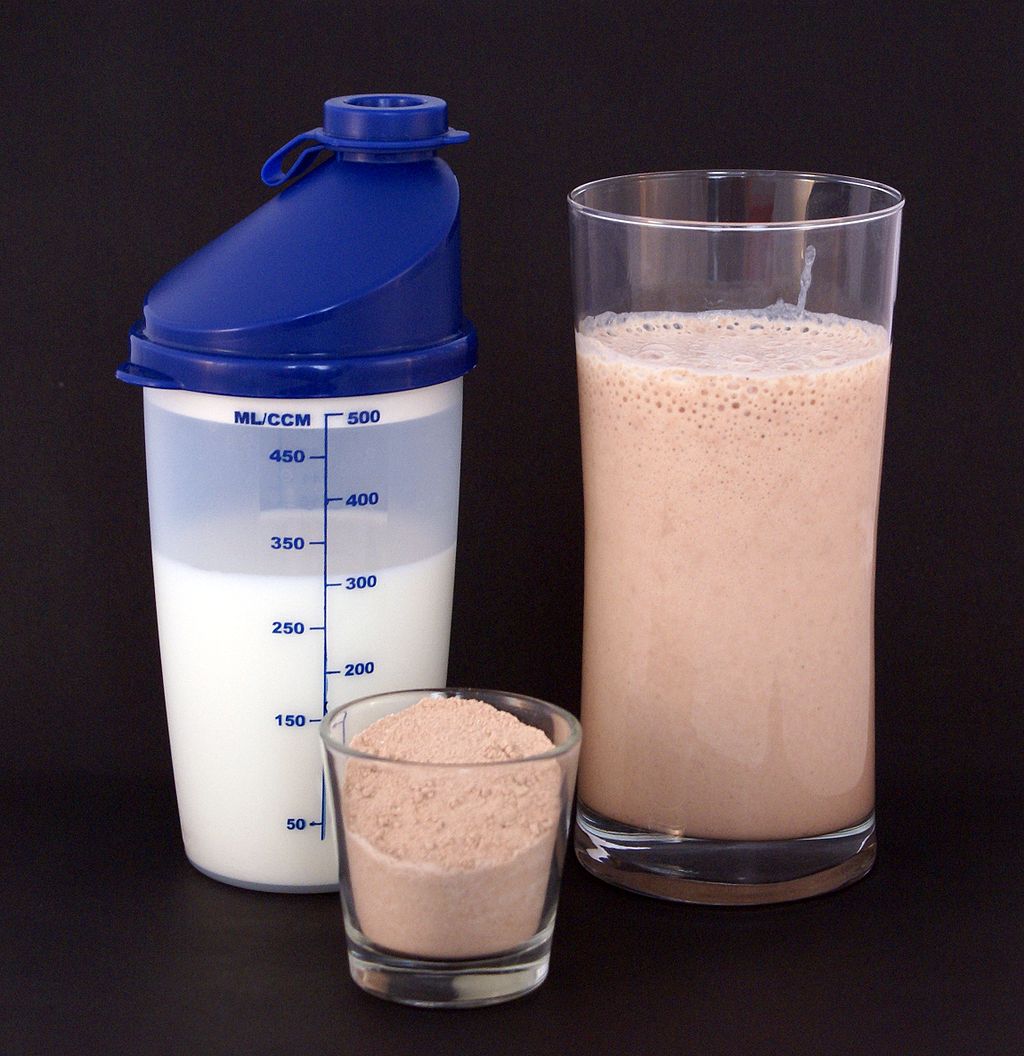
Drinks like this shake contain a lot of protein. Muscle tissue consists mainly of protein, so such drinks are popular with people who want to build muscle. Making up muscles is just one of a plethora of functions of this amazingly diverse class of biochemicals.
What Are Proteins?
Proteins are a major class of biochemical compounds made up of small monomer molecules called amino acids. More than 20 different amino acids are typically found in the proteins of living things. Small proteins may contain just a few hundred amino acids, while large proteins may contain thousands.
Protein Structure
When amino acids bind together, they may form short chains of two or just a few amino acids. These short chains are called peptides. When amino acids form long chains, the chains are called polypeptides. A protein consists of one or more polypeptides.
Proteins may have up to four levels of structure, from primary to quaternary. As a result, they can have tremendous diversity. Here are some additional details about the levels of protein structure:
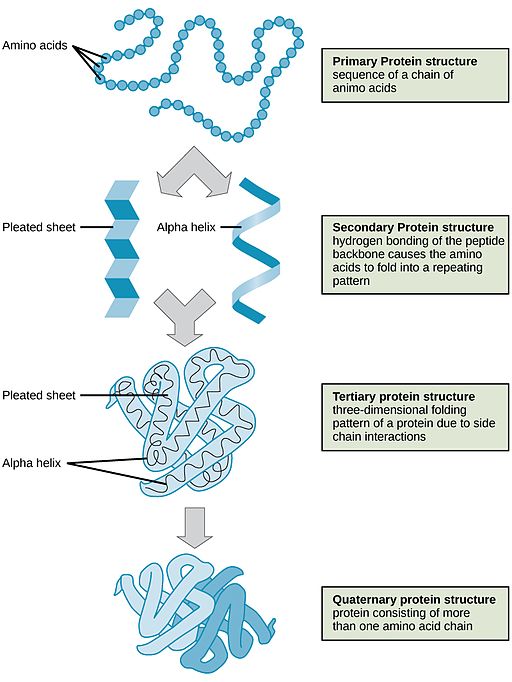
Figure 3.6.2 Four protein structures.
Functions of Proteins
The diversity of protein structures explains why this class of biochemical compounds can play so many important roles in living things. What are the roles of proteins?
- Some proteins have structural functions. They may help cells keep their shape or make up muscle tissues.
- Many proteins are enzymes that speed up chemical reactions in cells. Enzymes are usually highly specific and accelerate only one or a few chemical reactions. Thousands of different biochemical reactionsare known to be catalyzed by enzymes, including most of the reactions involved in metabolism. A reaction without an enzyme might take millions of years to complete, whereas with the proper enzyme, it may take just a few milliseconds!
- Other proteins are antibodies, which bind to specific foreign substances, like proteins on the surface of bacterial cells. This process targets the cells for destruction.
- Still other proteins carry messages or materials. Myoglobin, for example, is an oxygen-binding protein found in the muscle tissues of most mammals (including humans).
The chief characteristic of proteins that allows their diverse set of functions is their ability to bind to other molecules so specifically and tightly. Myoglobin can bind specifically and tightly with oxygen. The region of a protein responsible for binding with another molecule is known as the binding site. This site is often a depression on the molecular surface, determined largely by the tertiary structure of the protein.
Protein Consumption, Digestion, and Synthesis
Proteins are necessary in the diets of humans and other animals. We cannot make all the different amino acids we need, so we must obtain some of them from the foods we consume. In the process of digestion, we break down the proteins in food into free amino acids that can then be used to synthesize our own proteins. Protein synthesis from amino acid monomers takes place in all cells and is controlled by genes. Once new proteins are synthesized, they generally do not last very long before they are degraded and their amino acids are recycled. A protein's lifespan in mammalian cells is generally just a day or two.
3.6 Summary
- Proteins are a major class of biochemical compounds. They're made up of small monomer molecules called amino acids. More than 20 amino acids are commonly found in the proteins of living things. Proteins have tremendous diversity in terms of both structure and function.
- Long chains of amino acids form polypeptides. The sequence of amino acids in polypeptides makes up the primary structure of proteins. Proteins also have higher levels of structure. Secondary structure refers to configurations — such as helices and sheets — within polypeptide chains. Tertiary structure is a protein's overall three-dimensional shape, which controls the molecule's basic function. A quaternary structure forms if multiple protein molecules join together and function as a complex.
- Proteins help cells keep their shape, make up muscle tissues, act as enzymes or antibodies, and carry messages or materials. The chief characteristic that allows proteins' diverse functions is their ability to bind specifically and tightly with other molecules.
- We cannot make all the amino acids we need to synthesize our own proteins, so we must obtain some of them from proteins in the foods we consume.
3.6 Review Questions
- What are proteins?
- Outline the four levels of protein structure.
- Identify four functions of proteins.
- Explain why proteins can take on so many different functions in living things.
- What is the role of proteins in the human diet?
- Can you have a protein with both an alpha helix and a pleated sheet? Why or why not?
- If there is a mutation in a gene that causes a different amino acid to be encoded than the one usually encoded in that position within the protein, would that affect:
- The primary structure of the protein? Explain your answer.
- The higher structures (secondary, tertiary, quaternary) of the protein? Explain your answer.
- The function of the protein? Explain your answer.
- What is the region of a protein responsible for binding to another molecule? Which level or levels of protein structure creates this region?
- What is the region of a protein responsible for binding to another molecule? Which level or levels of protein structure creates this region?
-
- True or False: You can tell the function of all proteins based on their quaternary structure.
- Explain what the reading means when it says that amino acids are “recycled.”
3.6 Explore More
https://youtu.be/hok2hyED9go
Protein Structure and Folding by The Amoeba Sisters, 2018.
Attributions
Figure 3.6.1
Protein_shake by Sandstein, on Wikimedia Commons, is used under a CC BY 3.0 (https://creativecommons.org/licenses/by/3.0) license.
Figure 3.6.2
Structures of Protein by OpenStax, on Wikimedia Commons, is used under a CC BY 4.0 (https://creativecommons.org/licenses/by/4.0) license.
References
Amoeba Sisters. (2018, September 24). Protein structure and folding. YouTube. https://www.youtube.com/watch?v=hok2hyED9go
OpenStax. (2012, Aug 22). Figure 9. The four levels of protein structure can be observed in these illustrations. (credit: modification of work by National Human Genome Research Institute). In Biology. OpenStax CNX. © Rice University. https://cnx.org/contents/GFy_h8cu@10.53:2zzm1QG9@7/Proteins (last revised May 27, 2016).
Created by CK-12/Adapted by Christine Miller
Why Are Humans Such Sweaty Animals?
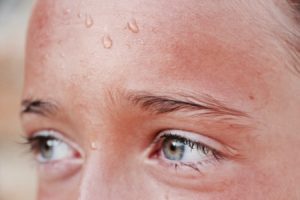
Combine exercise and a hot day, and you get sweat — and lots of it. Sweating is one of the adaptations humans have evolved to maintain homeostasis, or a constant internal environment. When sweat evaporates from the skin, it uses up some of the excess heat energy on the skin, thus helping to reduce the body's temperature. Humans are among the sweatiest of all species, with a fine-tuned ability to maintain a steady internal temperature, even at very high outside temperatures.
Unifying Principles of Biology
All living things have mechanisms for homeostasis. Homeostasis is one of four basic principles or theories that explain the structure and function of all species (including our own). Whether biologists are interested in ancient life, the life of bacteria, or how humans could live on Mars, they base their understanding of biology on these unifying principles:
- Cell theory
- Gene theory
- Homeostasis
- Evolutionary theory
Cell Theory
According to cell theory, all living things are made of cells, and living cells come only from other living cells. Each living thing begins life as a single cell. Some living things, including bacteria, remain single-celled. Other living things, including plants and animals, grow and develop into many cells. Your own body is made up of an amazing 100 trillion cells. But even you — like all other living things — began life as a single cell.
Watch this TED-Ed video about the origin of cell theory:
https://www.youtube.com/watch?v=4OpBylwH9DU
The Wacky History of Cell Theory - Lauren Royal-Woods, TED-Ed, 2012
Gene Theory
Gene theory is the idea that the characteristics of living things are controlled by genes, which are passed from parents to their offspring. Genes are located on larger structures called chromosomes. Chromosomes are found inside every cell, and they consist of molecules of DNA (deoxyribonucleic acid). Those molecules of DNA are encoded with instructions that "tell" cells how to behave.
Homeostasis
Homeostasis, or the condition in which a system is maintained in a more-or-less steady state, is a characteristic of individual living things, like the human ability to sweat. Homeostasis also applies to the entire biosphere, wherever life is found on Earth. Consider the concentration of oxygen in Earth's atmosphere. Oxygen makes up 21 per cent of the atmosphere, and this concentration is fairly constant. What maintains this homeostasis in the atmosphere? The answer is living things.
Most living things need oxygen to survive, so they remove oxygen from the air. On the other hand, many living things, including plants, give off oxygen when they convert carbon dioxide and water to food in the process of photosynthesis. These two processes balance out so the air maintains a constant level of oxygen.
Evolutionary Theory
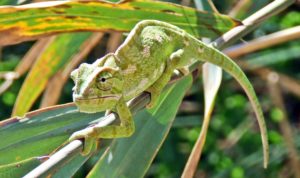
Evolution is a change in the characteristics of populations of living things over time. Evolution can occur by a process called natural selection, which results from random genetic mutations in a population. If these mutations lead to changes that allow the living things to better survive, then their chances of surviving and reproducing in a given environment increase. They will then pass more genes to the next generation. Over many generations, this can lead to major changes in the characteristics of those living things. Evolution explains how living things are changing today, as well as how modern living things descended from ancient life forms that no longer exist on Earth.
Traits that help living things survive and reproduce in a given environment are called adaptations. You can see an obvious adaptation in the image below. The chameleon is famous for its ability to change its colour to match its background as camouflage. Using camouflage, the chameleon can hide in plain sight.
Feature: Myth vs. Reality
Misconceptions about evolution are common. They include the following myths:
Myth |
Reality |
| "Evolution is "just" a theory or educated guess." | Scientists accept evolutionary theory as the best explanation for the diversity of life on Earth because of the large body of scientific evidence supporting it. Like any scientific theory, evolution is a broad, evidence-supported explanation for multiple phenomena. |
| "The theory of evolution explains how life on Earth began." | The theory of evolution explains how life changed on Earth after it began. |
| "The theory of evolution means that humans evolved from apes like those in zoos." | Humans and modern apes both evolved from a common ape-like ancestor millions of years ago. |
2.3 Summary
- Four basic principles or theories unify all fields of biology: cell theory, gene theory, homeostasis, and evolutionary theory.
- According to cell theory, all living things are made of cells and come from other living cells.
- Gene theory states that the characteristics of living things are controlled by genes that pass from parents to offspring.
- All living things strive to maintain internal balance, or homeostasis.
- The characteristics of populations of living things change over time through the process of micro-evolution as organisms acquire adaptations, or traits that better suit them to a given environment.
Use the flashcards below to review the four principles:
2.3 Review Questions
-
- How does sweating help the human body maintain homeostasis?
- Explain cell theory and gene theory.
- Describe an example of homeostasis in the atmosphere.
- Describe how you can apply the concepts of evolution,natural selection, adaptation, and homeostasis to the human ability to sweat.
- Which of the four unifying principles of biology is primarily concerned with:
- how DNA is passed down to offspring?
- how internal balance is maintained?
- _____________ are located on ______________.
- chromosomes; genes
- genes;chromosomes
- genes; traits
- none of the above
- Define an adaptation and give one example.
- Explain how gene theory and evolutionary theory relate to each other.
- Does evolution by natural selection occur within one generation? Why or why not?
- Explain why you think chameleons evolved the ability to change their colour to match their background, as well as how natural selection may have acted on the ancestors of chameleons to produce this adaptation.
2.3 Explore More
https://www.youtube.com/watch?v=Wg5DBH6uMCw&feature=emb_logo
Myths and misconceptions about evolution - Alex Gendler, TEDEd, 2013
Attributions
Figure 2.3.1
Photo(perspiration), by Hans Reniers on Unsplash. is used under the Unsplash license (https://unsplash.com/license).
Figure 2.3.2
Mediterranean Chameleon Reptile Lizard, by user:1588877 on Pixabay, is used under the Pixabay license (https://pixabay.com/de/service/license/).
References
TED-Ed. (2012, June 4). The wacky history of cell theory - Lauren Royal-Woods. YouTube. https://www.youtube.com/watch?v=4OpBylwH9DU&feature=youtu.be
TED-Ed. (2013, July 8). Myths and misconceptions about evolution - Alex Gendler. YouTube. https://www.youtube.com/watch?v=mZt1Gn0R22Q&t=10s
A semilunar valve in the hearth that separates the left ventricle and the aorta; preventing backflow of blood.
An acute, potentially life-threatening hypersensitivity reaction, involving the release of mediators from mast cells, basophils and recruited inflammatory cells. Anaphylaxis is defined by a number of signs and symptoms, alone or in combination, which occur within minutes, or up to a few hours, after exposure to a provoking agent. It can be mild, moderate to severe, or severe. Most cases are mild but any anaphylaxis has the potential to become life-threatening.
Created by: CK-12/Adapted by Christine Miller
Who's Who?
Figure 3.7.1 Identical twins show clearly the importance of genes in making us who we are. Genes would not be possible without nucleic acids.
What Are Nucleic Acids?
Nucleic acids are the class of biochemical compounds that includes DNA and RNA. These molecules are built of small monomers called nucleotides. Many nucleotides bind together to form a chain called a polynucleotide. The nucleic acid DNA (deoxyribonucleic acid) consists of two polynucleotide chains or strands. Thus, DNA is sometimes called double-stranded. The nucleic acid RNA (ribonucleic acid) consists of just one polynucleotide chain or strand, so RNA is sometimes called single-stranded.
Structure of Nucleic Acids
Each nucleotide consists of three smaller molecules:
- A sugar molecule (the sugar deoxyribose in DNA and the sugar ribose in RNA)
- A phosphate group
- A nitrogen base
The nitrogen bases in a nucleic acid stick out from the backbone. There are four different nitrogen bases: cytosine, adenine, guanine, and either thymine (in DNA) or uracil (in RNA). In DNA, bonds form between bases on the two nucleotide chains and hold the chains together. Each type of base binds with just one other type of base: cytosine always binds with guanine, and adenine always binds with thymine. These pairs of bases are called complementary base pairs.
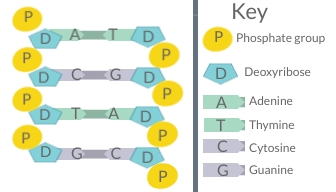
As you can see in Figure 3.7.2, sugars and phosphate groups form the backbone of a polynucleotide chain. Hydrogen bonds between complementary bases hold the two polynucleotide chains together.
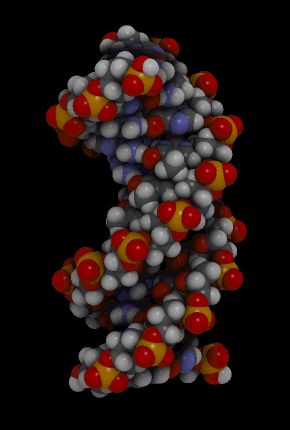
The binding of complementary bases causes DNA molecules automatically to take their well-known double helix shape, which is shown in the animation in Figure 3.7.3. A double helix is like a spiral staircase. It forms naturally and is very strong, making the two polynucleotide chains difficult to break apart.
DNA Molecule. Hydrogen bonds between complementary bases help form the double helix of a DNA molecule. The letters A, T, G, and C stand for the bases adenine, thymine, guanine, and cytosine. The sequence of these four bases in DNA is a code that carries instructions for making proteins. Shown is a representation of how the double helix folds into a chromosome.
Roles of Nucleic Acids
DNA makes up genes, and the sequence of bases in DNA makes up the genetic code. Between “starts” and “stops,” the code carries instructions for the correct sequence of amino acids in a protein. RNA uses the information in DNA to assemble the correct amino acids and help make the protein. The information in DNA is passed from parent cells to daughter cells whenever cells divide, and it is also passed from parents to offspring when organisms reproduce. This is how inherited characteristics are passed from one generation to the next.
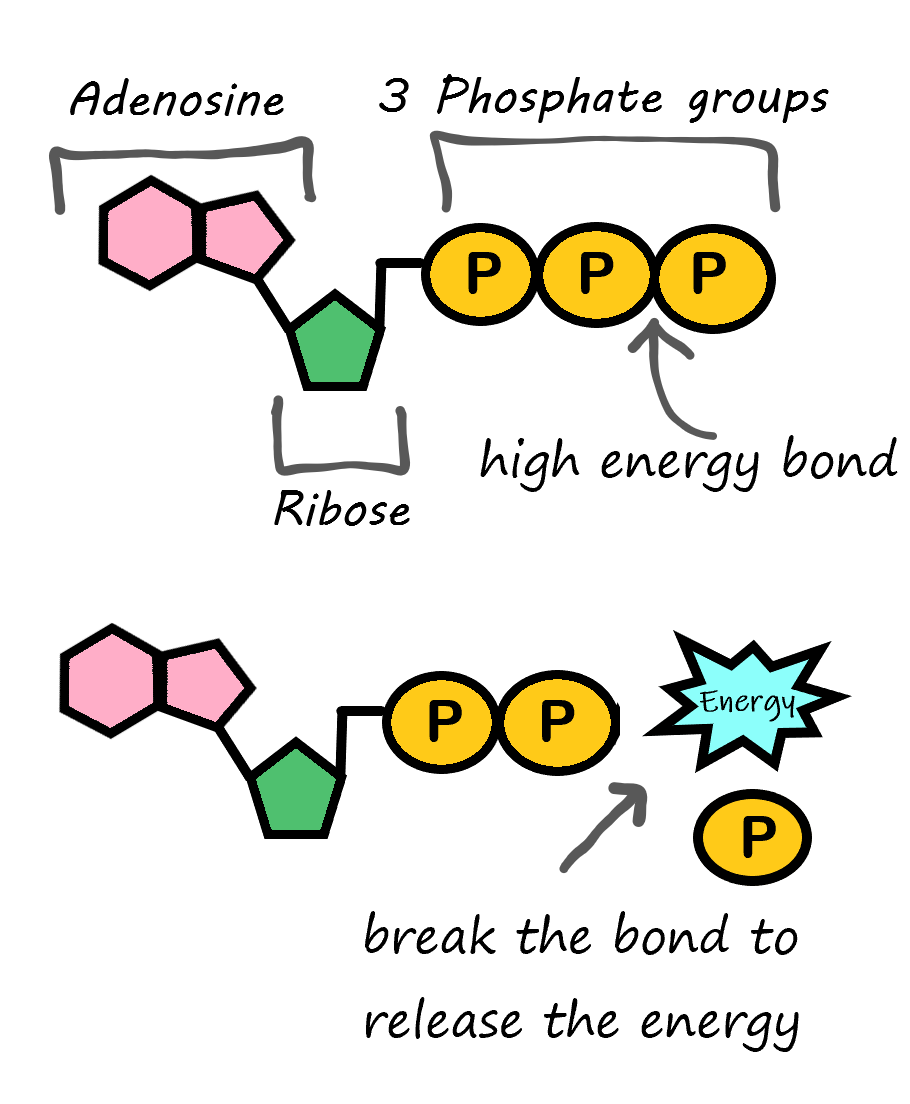
ATP is Energy
There is one type of specialized nucleic acid that exists only as a monomer. It stands apart from the other nucleic acids because it does not code for, or help create, proteins. This molecule is ATP, which stands for adenosine triphosphate. It consists of a sugar, adenosine, and three phosphate groups. It's primary role is as the basic energy currency in the cell. The way ATP works is all based on the phosphates. As shown in Figure 3.7.4, a large amount of energy is stored in the bond between the second and third phosphate group. When this bond is broken, it functions as an exothermic reaction and this energy can be used to power other processes taking place in the cell.
3.7 Summary
- Nucleic acids are the class of biochemical compounds that includes DNA and RNA. These molecules are built of small monomers called nucleotides, which bind together in long chains to form polynucleotides. DNA consists of two polynucleotides, and RNA consists of one polynucleotide.
- Each nucleotide consists of a sugar molecule, phosphate group, and nitrogen base. Sugars and phosphate groups of adjacent nucleotides bind together to form the "backbone" of the polynucleotide. Nitrogen bases jut out to the side of the sugar-phosphate backbone. Bonds between complementary bases hold together the two polynucleotide chains of DNA and cause it to take on its characteristic double helix shape.
- DNA makes up genes, and the sequence of nitrogen bases in DNA makes up the genetic code for the synthesis of proteins. RNA helps synthesize proteins in cells. The genetic code in DNA is also passed from parents to offspring during reproduction, which explains how inherited characteristics are passed from one generation to the next.
3.7 Review Questions
- What are nucleic acids?
- How does RNA differ structurally from DNA? Draw a picture of each.
- Describe a nucleotide. Explain how nucleotides bind together to form a polynucleotide.
- What role do nitrogen bases in nucleotides play in the structure and function of DNA?
- What is a function of RNA?
- Using what you learned in this article about nucleic acids, explain why twins look so similar.
-
- What are the nucleotides on the complementary strand of DNA below?
- Arrange the following in order from the smallest to the largest level of organization: DNA, nucleotide, polynucleotide.
- As part of the DNA replication process, the two polynucleotide chains are separated from each other, but each individual chain remains intact. What type of bonds are broken in this process?
- Adenine, guanine, cytosine, and thymine are _______________.
- Some diseases and disorders are caused by genes. Explain why these genetic disorders can be passed down from parents to their children.
- Are there any genetic disorders that run in your family?
3.7 Explore More
https://www.youtube.com/watch?v=aeAL6xThfL8
DNA: The book of you - Joe Hanson, TED-Ed, 2012.
Attributions
Figure 3.7.1
- Twins sitting next to each other by Craig Adderley on Pexels is used under the Pexels license (https://www.pexels.com/license/).
- Photograph Of Women Wearing Strip Shirt by Paul Bonafide Eferiano on Pexels is used under the Pexels license (https://www.pexels.com/license/).
- Two guys sitting on a beach by Daria Shevtsova on Pexels is used under the Pexels license (https://www.pexels.com/license/).
- Children Twins Girls Young Nicaraguan Portrait by skeeze on Pixabay is used under the Pixabay License (https://pixabay.com/service/license/).
Figure 3.7.2
DNA-diagram by Christine Miller [Christinelmiller] on Wikimedia Commons, is used under a CC BY 4.0 (https://creativecommons.org/licenses/by/4.0) license.
Figure 3.7.3
Bdna_cropped [gif] by Spiffistan, derivative work: Jahobr, on Wikimedia Commons, is released into the public domain (https://en.wikipedia.org/wiki/Public_domain).
Figure 3.7.4
ATP for energy by Christine Miller is used under a CC BY 4.0 (https://creativecommons.org/licenses/by/4.0/) license.
Reference
TED-Ed. (2012, November 26). DNA: The book of you - Joe Hanson. YouTube, 2012. https://www.youtube.com/watch?v=aeAL6xThfL8&feature=youtu.be
Created by: CK-12/Adapted by Christine Miller
After reading this chapter, you should be able to see numerous connections between chemistry, human life, and health. In Joseph’s situation, chemistry is involved in the reasons why his father has diabetes, why his personal risk of getting diabetes is high, and why the dietary changes he is considering could be effective.
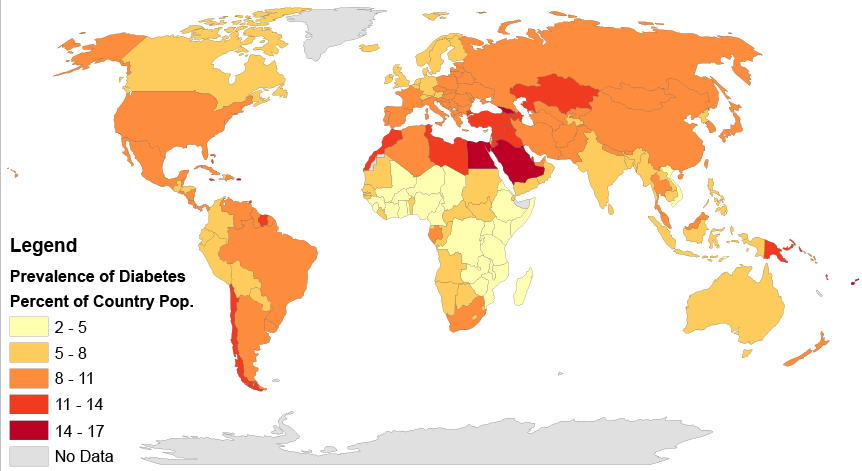
Type 2 diabetes affects populations worldwide and is caused primarily by a lack of response in the body to the hormone insulin, which causes problems in the regulation of blood sugar, or glucose. Insulin is a peptide hormone, and as you have learned, peptides are chains of amino acids. Therefore, insulin is in the class of biochemical compounds called proteins. Joseph is at increased risk of diabetes partly because there is a genetic component to the disease. DNA, which is a type of chemical compound called a nucleic acid, is passed down from parents to their offspring, and carries the instructions for the production of proteins in units called genes. If there is a problem in a gene (or genes) that contributes to the development of a disease, such as type 2 diabetes, this can get passed down to the offspring and may raise that child’s risk of getting the disease.
But genetics is only part of the reason why Joseph is at an increased risk of diabetes. Obesity itself is a risk factor, and one that can be shared in families due to shared lifestyle factors (such as poor diet and lack of exercise), as well as genetics. Consumption of too many refined carbohydrates (like white bread and soda) may also contribute to obesity and the development of diabetes. As you probably now know, these simple carbohydrates are more easily and quickly broken down in the digestive system into glucose than larger complex carbohydrate molecules, such as those found in vegetables and whole grains. This can lead to dramatic spikes in blood sugar levels, which is particularly problematic for people with diabetes because they have trouble maintaining their blood sugar at a safe level. You can understand why Joseph’s father limits his consumption of refined carbohydrates, and in fact, some scientific studies have shown that avoiding refined carbohydrates may actually help reduce the risk of getting diabetes in the first place.
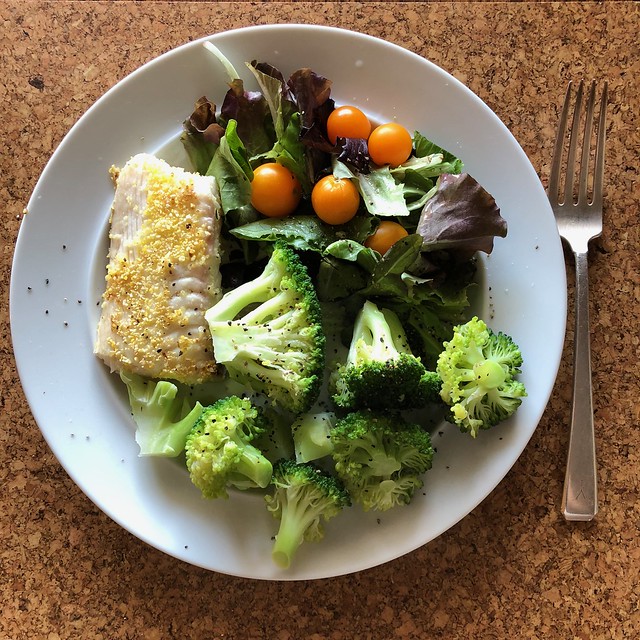
Joseph’s friend recommended eating a low fat, high carbohydrate diet to lose weight, but you can see that the type of carbohydrate — simple or complex — is an important consideration. Eating a large amount of white bread and rice may not help Joseph reduce his risk of diabetes, but a healthy diet that helps him lose weight may lower his risk of diabetes, since obesity itself is a factor. Which specific diet will work best to help him lose weight probably depends on a variety of factors, including his biology, lifestyle, and food preferences. Joseph should consult with his doctor about his diet and exercise plan, so that his specific situation can be taken into account and monitored by a medical professional.
Drinking enough water is usually good advice for everyone, especially if it replaces sugary drinks like soda. You now know that water is important for many of the chemical reactions that take place in the body. But you can have too much of a good thing — as in the case of marathon runners who can make themselves sick from drinking too much water! As you can see, proper balance, or homeostasis, is very important to the health of living organisms.
Finally, you probably now realize that “chemicals” do not have to be scary, toxic substances. All matter consists of chemicals, including water, your body, and healthy fresh fruits and vegetables, like the ones pictured in Figure 3.12.2. When people advocate “clean eating” and avoiding “chemicals” in food, they are usually referring to avoiding synthetic — or man-made — chemical additives, such as preservatives. This can be a healthy way to eat because it involves eating a variety of whole, fresh, unprocessed foods. But there is no reason to be scared of chemicals in general — they are simply molecules and how they react depends on what they are, what other molecules are present, and the environmental conditions surrounding them.
Chapter 3 Summary
By now, you should have a good understanding of the basics of the chemistry of life. Specifically, you have learned:
- All matter consists of chemical substances. A chemical substance has a definite and consistent composition and may be either an element or a compound.
- An element is a pure substance that cannot be broken down into other types of substances.
- An atom is the smallest particle of an element that still has the properties of that element. Atoms, in turn, are composed of subatomic particles, including negative electrons, positive protons, and neutral neutrons. The number of protons in an atom determines the element it represents.
- Atoms have equal numbers of electrons and protons, so they have no charge. Ions are atoms that have lost or gained electrons, so they have either a positive or negative charge. Atoms with the same number of protons but different numbers of neutrons are called isotopes.
- There are almost 120 known elements. The majority of elements are metals. A smaller number are nonmetals, including carbon, hydrogen, and oxygen.
- A compound is a substance that consists of two or more elements in a unique composition. The smallest particle of a compound is called a molecule. Chemical bonds hold together the atoms of molecules. Compounds can form only in chemical reactions, and they can break down only in other chemical reactions.
- Biochemical compounds are carbon-based compounds found in living things. They make up cells and other structures of organisms and carry out life processes. Most biochemical compounds are large molecules called polymers that consist of many repeating units of smaller molecules called monomers.
- There are millions of different biochemical compounds, but all of them fall into four major classes: carbohydrates, lipids, proteins, and nucleic acids.
- Carbohydrates are the most common class of biochemical compounds. They provide cells with energy, store energy, and make up organic structures, such as the cell walls of plants. The basic building block of carbohydrates is the monosaccharide.
- Sugars are short-chain carbohydrates that supply us with energy. Simple sugars, such as glucose, consist of just one monosaccharide. Some sugars, such as sucrose (or table sugar) consist of two monosaccharides and are called disaccharides.
- Complex carbohydrates, or polysaccharides, consist of hundreds or even thousands of monosaccharides. They include starch, glycogen, cellulose, and chitin.
- Starch is made by plants to store energy and is readily broken down into its component sugars during digestion.
- Glycogen is made by animals and fungi to store energy and plays a critical part in the homeostasis of blood glucose levels in humans.
- Cellulose is the most common biochemical compound in living things. It forms the cell walls of plants and certain algae. Humans cannot digest cellulose, but it makes up most of the crucial dietary fibre in the human diet.
- Chitin makes up organic structures, such as the cell walls of fungi and the exoskeletons of insects and other arthropods.
- Lipids include fats and oils. They store energy, form cell membranes, and carry messages.
- Lipid molecules consist mainly of repeating units called fatty acids. Fatty acids may be saturated or unsaturated, depending on the proportion of hydrogen atoms they contain. Animals store fat as saturated fatty acids, while plants store fat as unsaturated fatty acids.
- Types of lipids include triglycerides, phospholipids, and steroids.
- Triglycerides contain glycerol (an alcohol) in addition to fatty acids. Humans and other animals store fat as triglycerides in fat cells.
- Phospholipids contain phosphate and glycerol in addition to fatty acids. They are the main component of cell membranes in all living things.
- Steroids are lipids with a four-ring structure. Some steroids, such as cholesterol, are important components of cell membranes. Many other steroids are hormones.
- In living things, proteins include enzymes, antibodies, and numerous other important compounds. They help cells keep their shape, make up muscles, speed up chemical reactions, and carry messages and materials (among other functions).
- Proteins are made up of small monomer molecules called amino acids.
- Long chains of amino acids form polypeptides. The sequence of amino acids in polypeptides makes up the primary structure of proteins. Secondary structure refers to configurations such as helices and sheets within polypeptide chains. Tertiary structure is a protein's overall three-dimensional shape, which controls the molecule's basic function. A quaternary structure forms if multiple protein molecules join together and function as a complex.
- The chief characteristic that allows proteins' diverse functions is their ability to bind specifically and tightly with other molecules.
- Nucleic acids include DNA and RNA. They encode instructions for making proteins, helping make proteins, and passing the encoded instructions from parents to offspring.
- Nucleic acids are built of monomers called nucleotides, which bind together in long chains to form polynucleotides. DNA consists of two polynucleotides, and RNA consists of one polynucleotide.
- Each nucleotide consists of a sugar molecule, phosphate group, and nitrogen base. Sugars and phosphate groups of adjacent nucleotides bind together to form the "backbone" of the polynucleotide. Bonds between complementary bases hold together the two polynucleotide chains of DNA and cause it to take on its characteristic double helix shape.
- DNA makes up genes, and the sequence of nitrogen bases in DNA makes up the genetic code for the synthesis of proteins. RNA helps synthesize proteins in cells. The genetic code in DNA is also passed from parents to offspring during reproduction, explaining how inherited characteristics are passed from one generation to the next.
- A chemical reaction is a process that changes some chemical substances into others. A substance that starts a chemical reaction is called a reactant, and a substance that forms in a chemical reaction is called a product. During the chemical reaction, bonds break in reactants and new bonds form in products.
- Chemical reactions can be represented by chemical equations. According to the law of conservation of mass, mass is always conserved in a chemical reaction, so a chemical equation must be balanced, with the same number of atoms of each type of element in the products as in the reactants.
- Many chemical reactions occur all around us each day, such as iron rusting and organic matter rotting, but not all changes are chemical processes. Some changes, such as ice melting or paper being torn into smaller pieces, are physical processes that do not involve chemical reactions and the formation of new substances.
- All chemical reactions involve energy, and they require activation energy to begin. Exothermic reactions release energy. Endothermic reactions absorb energy.
- Biochemical reactions are chemical reactions that take place inside living things. The sum of all the biochemical reactions in an organism is called metabolism. Metabolism includes catabolic reactions (exothermic reactions) and anabolic reactions (endothermic reactions).
- Most biochemical reactions require a biological catalyst called an enzyme to speed up the reaction by reducing the amount of activation energy needed for the reaction to begin. Most enzymes are proteins that affect just one specific substance, called the enzyme's substrate.
- Virtually all living things on Earth require liquid water. Only a tiny per cent of Earth's water is fresh liquid water. Water exists as a liquid over a wide range of temperatures, and it dissolves many substances. These properties depend on water's polarity, which causes water molecules to "stick" together through weak bonds called hydrogen bonds.
- The human body is about 70 per cent water (outside of fat). Organisms need water to dissolve many substances and for most biochemical processes, including photosynthesis and cellular respiration.
- A solution is a mixture of two or more substances that has the same composition throughout. Many solutions consist of water and one or more dissolved substances.
- Acidity is a measure of the hydronium ion concentration in a solution. Pure water has a very low concentration and a pH of 7, which is the point of neutrality on the pH scale. Acids have a higher hydronium ion concentration than pure water and a pH lower than 7. Bases have a lower hydronium ion concentration than pure water and a pH higher than 7.
- Many acids and bases in living things are secreted to provide the proper pH for enzymes to work properly.
Now you understand the chemistry of the molecules that make up living things. In the next chapter, you will learn how these molecules make up the basic unit of structure and function in living organisms — cells — and you will be able to understand some of the crucial chemical reactions that occur within cells.
Chapter 3 Review
-
- The chemical formula for the complex carbohydrate glycogen is C24H42O21.
- What are the elements in glycogen?
- How many atoms are in one molecule of glycogen?
- Is glycogen an ion? Why or why not?
- Is glycogen a monosaccharide or a polysaccharide? Besides memorizing this fact, how would you know this based on the information in the question?
- What is the function of glycogen in the human body?
- What is the difference between an ion and a polar molecule? Give an example of each in your explanation.
- Define monomer and polymer.
-
- What is the difference between a protein and a polypeptide?
-
- People with diabetes have trouble controlling the level of glucose in their bloodstream. Knowing this, why do you think it is often recommended that people with diabetes limit their consumption of carbohydrates?
- Identify each of the following reactions as endothermic or exothermic.
- cellular respiration
- photosynthesis
- catabolic reactions
- anabolic reactions
- Pepsin is an enzyme in the stomach that helps us digest protein. Answer the following questions about pepsin:
- What is the substrate for pepsin?
- How does pepsin work to speed up protein digestion?
- Given what you know about the structure of proteins, what do you think are some of the products of the reaction that pepsin catalyzes?
- The stomach is normally acidic. What do you think would happen to the activity of pepsin and protein digestion if the pH is raised significantly?
Attributions
Figure 3.13.1
Prevalence_of_Diabetes_by_Percent_of_Country_Population_(2014)_Gradient_Map by Walter Scott Wilkens [Wwilken2], University of Illinois - Urbana Champaign Department of Geography and GIScience, on Wikimedia Commons, is used under a CC BY-SA 4.0 (https://creativecommons.org/licenses/by-sa/4.0) license.
Figure 3.13.2
Healthy plate by Melinda Young Stuart on Flickr is used under a CC BY-NC-ND 2.0 (https://creativecommons.org/licenses/by-nc-nd/2.0/) license.
Created by: CK-12/Adapted by Christine Miller
Figure 4.2.1 Human cells viewed with a very powerful tool called a scanning electron microscope.
Amazing Cells
What are these incredible objects? Would it surprise you to learn that they are all human cells? Cells are actually too small to see with the unaided eye. It is visible here in such detail because it is being viewed with a very powerful tool called a scanning electron microscope. Cells may be small in size, but they are extremely important to life. Like all other living things, you are made of cells. Cells are the basis of life, and without cells, life as we know it would not exist. You will learn more about these amazing building blocks of life in this section.
What Are Cells?
If you look at living matter with a microscope — even a simple light microscope — you will see that it consists of cells. Cells are the basic units of the structure and function of living things. They are the smallest units that can carry out the processes of life. All organisms are made up of one or more cells, and all cells have many of the same structures and carry out the same basic life processes. Knowing the structure of cells and the processes they carry out is necessary to an understanding of life itself.

Discovery of Cells
The first time the word cell was used to refer to these tiny units of life was in 1665 by a British scientist named Robert Hooke. Hooke was one of the earliest scientists to study living things under a microscope. The microscopes of his day were not very strong, but Hooke was still able to make an important discovery. When he looked at a thin slice of cork under his microscope, he was surprised to see what looked like a honeycomb. Hooke made the drawing in the figure to the right to show what he saw. As you can see, the cork was made up of many tiny units. Hooke called these units cells because they resembled cells in a monastery.
Soon after Robert Hooke discovered cells in cork, Anton van Leeuwenhoek in Holland made other important discoveries using a microscope. Leeuwenhoek made his own microscope lenses, and he was so good at it that his microscope was more powerful than other microscopes of his day. In fact, Leeuwenhoek’s microscope was almost as strong as modern light microscopes. Using his microscope, Leeuwenhoek was the first person to observe human cells and bacteria.
Cell Theory
By the early 1800s, scientists had observed cells of many different organisms. These observations led two German scientists named Theodor Schwann and Matthias Jakob Schleiden to propose cells as the basic building blocks of all living things. Around 1850, a German doctor named Rudolf Virchow was studying cells under a microscope, when he happened to see them dividing and forming new cells. He realized that living cells produce new cells through division. Based on this realization, Virchow proposed that living cells arise only from other living cells.
The ideas of all three scientists — Schwann, Schleiden, and Virchow — led to cell theory, which is one of the fundamental theories unifying all of biology.
Cell theory states that:
- All organisms are made of one or more cells.
- All the life functions of organisms occur within cells.
- All cells come from existing cells.
Seeing Inside Cells
Starting with Robert Hooke in the 1600s, the microscope opened up an amazing new world — a world of life at the level of the cell. As microscopes continued to improve, more discoveries were made about the cells of living things, but by the late 1800s, light microscopes had reached their limit. Objects much smaller than cells (including the structures inside cells) were too small to be seen with even the strongest light microscope.
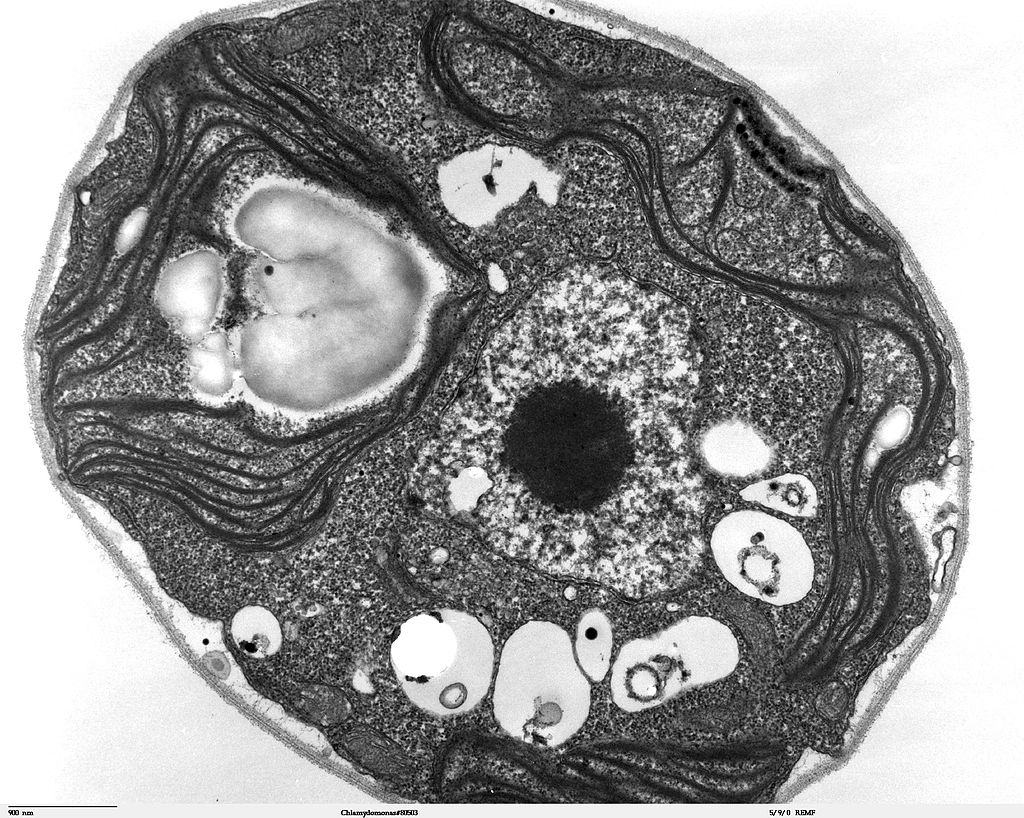
Then, in the 1950s, a new type of microscope was invented. Called the electron microscope, it used a beam of electrons instead of light to observe extremely small objects. With an electron microscope, scientists could finally see the tiny structures inside cells. They could even see individual molecules and atoms. The electron microscope had a huge impact on biology. It allowed scientists to study organisms at the level of their molecules, and it led to the emergence of the molecular biology field. With the electron microscope, many more cell discoveries were made.
Structures Shared By All Cells
Although cells are diverse, all cells have certain parts in common. These parts include a plasma membrane, cytoplasm, ribosomes, and DNA.
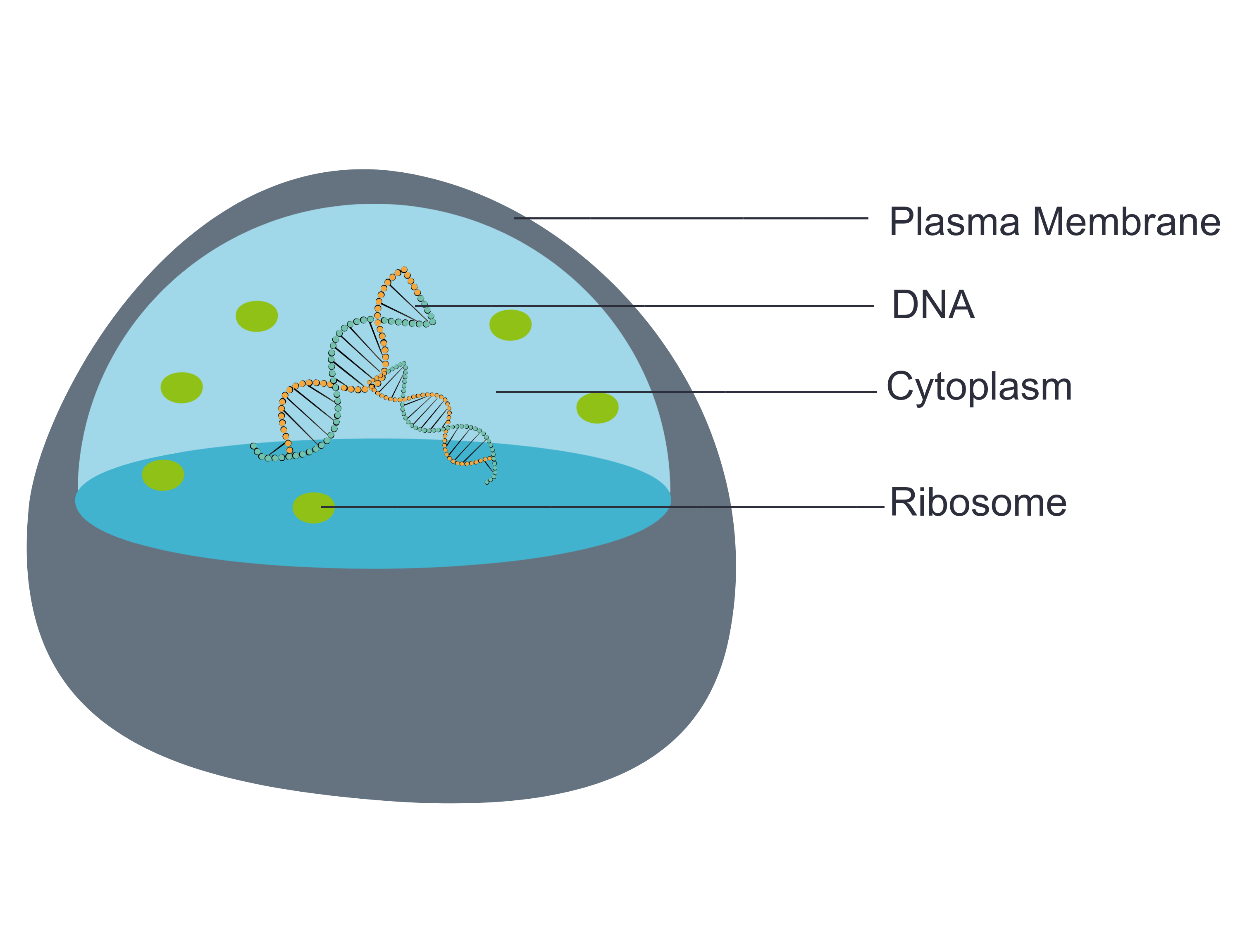
- The plasma membrane (a type of cell membrane) is a thin coat of lipids that surrounds a cell. It forms the physical boundary between the cell and its environment. You can think of it as the “skin” of the cell.
- Cytoplasm refers to all of the cellular material inside of the plasma membrane. Cytoplasm is made up of a watery substance called cytosol, and it contains other cell structures, such as ribosomes.
- Ribosomes are the structures in the cytoplasm in which proteins are made.
- DNA is a nucleic acid found in cells. It contains the genetic instructions that cells need to make proteins.
These four parts are common to all cells, from organisms as different as bacteria and human beings. How did all known organisms come to have such similar cells? The similarities show that all life on Earth has a common evolutionary history.
4.2 Summary
- Cells are the basic units of structure and function in living things. They are the smallest units that can carry out the processes of life.
- In the 1600s, Hooke was the first to observe cells from an organism (cork). Soon after, microscopist van Leeuwenhoek observed many other living cells.
- In the early 1800s, Schwann and Schleiden theorized that cells are the basic building blocks of all living things. Around 1850, Virchow observed cells dividing. To previous learnings, he added that living cells arise only from other living cells. These ideas led to cell theory, which states that all organisms are made of cells, that all life functions occur in cells, and that all cells come from other cells.
- It wasn't until the 1950s that scientists could see what was inside the cell. The invention of the electron microscope allowed them to see organelles and other structures smaller than cells.
- There is variation in cells, but all cells have a plasma membrane, cytoplasm, ribosomes, and DNA. These similarities show that all life on Earth has a common ancestor in the distant past.
4.2 Review Questions
- Describe cells.
- Explain how cells were discovered.
- Outline the development of cell theory.
-
- Identify the structures shared by all cells.
- Proteins are made on _____________ .
-
- Robert Hooke sketched what looked like honeycombs — or repeated circular or square units — when he observed plant cells under a microscope.
- What is each unit?
- Of the shared parts of all cells, what makes up the outer surface of each unit?
- Of the shared parts of all cells, what makes up the inside of each unit?
4.2 Explore More
https://www.youtube.com/watch?v=8IlzKri08kk
Introduction to Cells: The Grand Cell Tour, by The Amoeba Sisters, 2016.
Attributions
Figure 4.2.1
- A white blood cell (WBC) known as a neutrophil by National Institute of Allergy and Infectious Diseases (NIAID) on the CDC/ Public Health Image Library (PHIL) Photo ID# 18129. is in the public domain (https://en.wikipedia.org/wiki/Public_domain).
- Healthy Human T Cell by NIAID on Flickr. is used under a CC BY 2.0 (https://creativecommons.org/licenses/by/2.0/) license.
- Human natural killer cell by NIAID on Flickr. is used under a CC BY 2.0 (https://creativecommons.org/licenses/by/2.0/) license.
- Human blood with red blood cells, T cells (orange) and platelets (green) by ZEISS Microscopy on Flickr. is used under a CC BY-NC-ND 2.0 (https://creativecommons.org/licenses/by-nc-nd/2.0/) license.
- Developing nerve cells by ZEISS Microscopy on Flickr. is used under a CC BY-NC-ND 2.0 (https://creativecommons.org/licenses/by-nc-nd/2.0/) license.
Figure 4.2.2
Hooke-microscope-cork by Robert Hooke (1635-1702) [uploaded by Alejandro Porto] on Wikimedia Commons is released into the public domain (https://en.wikipedia.org/wiki/Public_domain).
Figure 4.2.3
Electron Microscope image of a cell by Dartmouth Electron Microscope Facility, Dartmouth College on Wikimedia Commons is released into the public domain (https://en.wikipedia.org/wiki/Public_domain).
Figure 4.2.4
Basic-Components-of-a-cell by Christine Miller is used under a CC0 1.0 (https://creativecommons.org/publicdomain/zero/1.0/) license.
References
Amoeba Sisters. (2016, November 1). Introduction to cells: The grand cell tour. YouTube. https://www.youtube.com/watch?v=8IlzKri08kk&feature=youtu.be
National Institute of Allergy and Infectious Diseases (NIAID). (2011). A white blood cell (WBC) known as a neutrophil, as it was in the process of ingesting a number of spheroid shaped, methicillin-resistant, Staphylococcus aureus (MRSA) bacteria [digital image]. CDC/ Public Health Image Library (PHIL) Photo ID# 18129. https://phil.cdc.gov/Details.aspx?pid=18129.
Wikipedia contributors. (2020, June 24). Antonie van Leeuwenhoek. In Wikipedia. https://en.wikipedia.org/w/index.php?title=Antonie_van_Leeuwenhoek&oldid=964339564
Wikipedia contributors. (2020, May 25). Matthias Jakob Schleiden. In Wikipedia. https://en.wikipedia.org/w/index.php?title=Matthias_Jakob_Schleiden&oldid=958819219
Wikipedia contributors. (2020, June 4). Rudolf Virchow. In Wikipedia,. https://en.wikipedia.org/w/index.php?title=Rudolf_Virchow&oldid=960708716
Wikipedia contributors. (2020, May 16). Theodor Schwann. In Wikipedia. https://en.wikipedia.org/w/index.php?title=Theodor_Schwann&oldid=956919239
Created by: CK-12/Adapted by Christine Miller
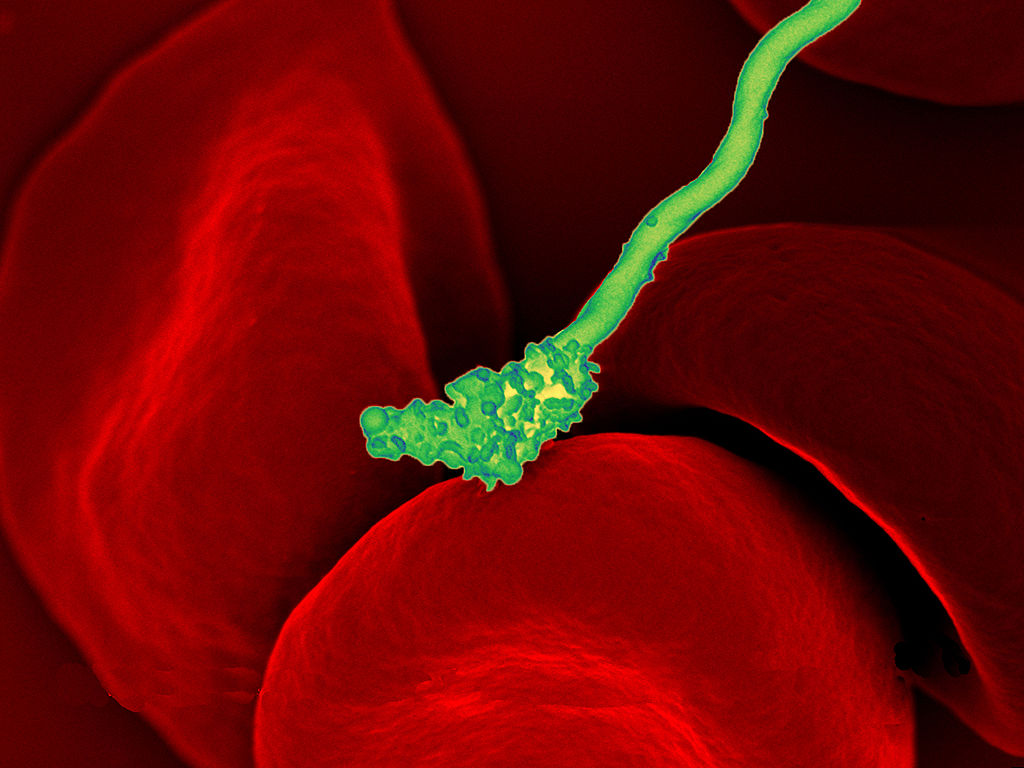
Bacteria Attack!
The colourful image in Figure 4.3.1 shows a bacterial cell (in green) attacking human red blood cells. The bacterium causes a disease called relapsing fever. The bacterial and human cells look very different in size and shape. Although all living cells have certain things in common — such as a plasma membrane and cytoplasm — different types of cells, even within the same organism, may have their own unique structures and functions. Cells with different functions generally have different shapes that suit them for their particular job. Cells vary not only in shape, but also in size, as this example shows. In most organisms, however, even the largest cells are no bigger than the period at the end of this sentence. Why are cells so small?
Explaining Cell Size
Most organisms, even very large ones, have microscopic cells. Why don't cells get bigger instead of remaining tiny and multiplying? Why aren't you one giant cell rolling around school? What limits cell size?
Once you know how a cell functions, the answers to these questions are clear. To carry out life processes, a cell must be able to quickly pass substances in and out of the cell. For example, it must be able to pass nutrients and oxygen into the cell and waste products out of the cell. Anything that enters or leaves a cell must cross its outer surface. The size of a cell is limited by its need to pass substances across that outer surface.
Look at the three cubes in Figure 4.3.2. A larger cube has less surface area relative to its volume than a smaller cube. This relationship also applies to cells — a larger cell has less surface area relative to its volume than a smaller cell. A cell with a larger volume also needs more nutrients and oxygen, and produces more waste. Because all of these substances must pass through the surface of the cell, a cell with a large volume will not have enough surface area to allow it to meet its needs. The larger the cell is, the smaller its ratio of surface area to volume, and the more difficult it will be for the cell to get rid of its waste and take in necessary substances. This is what limits the size of the cell.
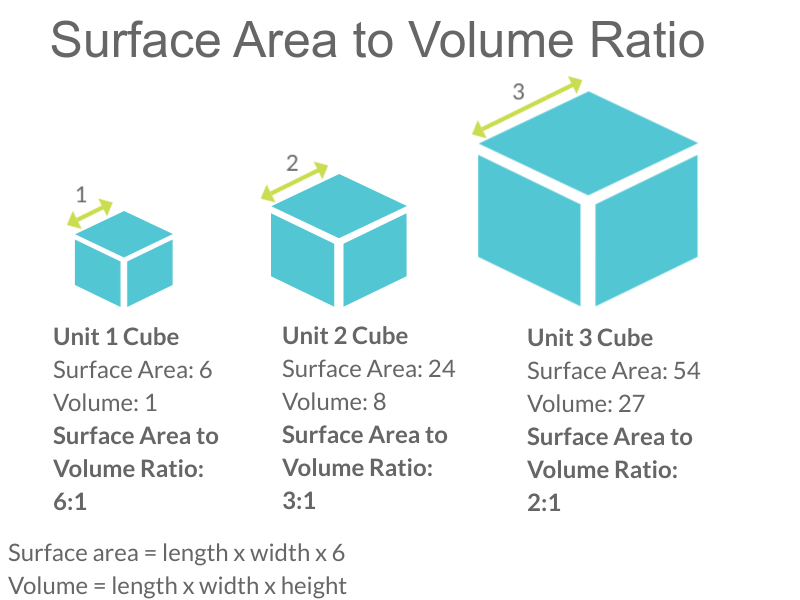
Cell Form and Function
Cells with different functions often have varying shapes. The cells pictured below (Figure 4.3.3) are just a few examples of the many different shapes that human cells may have. Each type of cell has characteristics that help it do its job. The job of the nerve cell, for example, is to carry messages to other cells. The nerve cell has many long extensions that reach out in all directions, allowing it to pass messages to many other cells at once. Do you see the tail of each tiny sperm cell? Its tail helps a sperm cell "swim" through fluids in the female reproductive tract in order to reach an egg cell. The white blood cell has the job of destroying bacteria and other pathogens. It is a large cell that can engulf foreign invaders.
Figure 4.3.3 Human cells may have many different shapes that help them to do their jobs.
Cells With and Without a Nucleus
The nucleus is a basic cell structure present in many — but not all — living cells. The nucleus of a cell is a structure in the cytoplasm that is surrounded by a membrane (the nuclear membrane) and contains DNA. Based on whether or not they have a nucleus, there are two basic types of cells: prokaryotic cells and eukaryotic cells.
Prokaryotic Cells
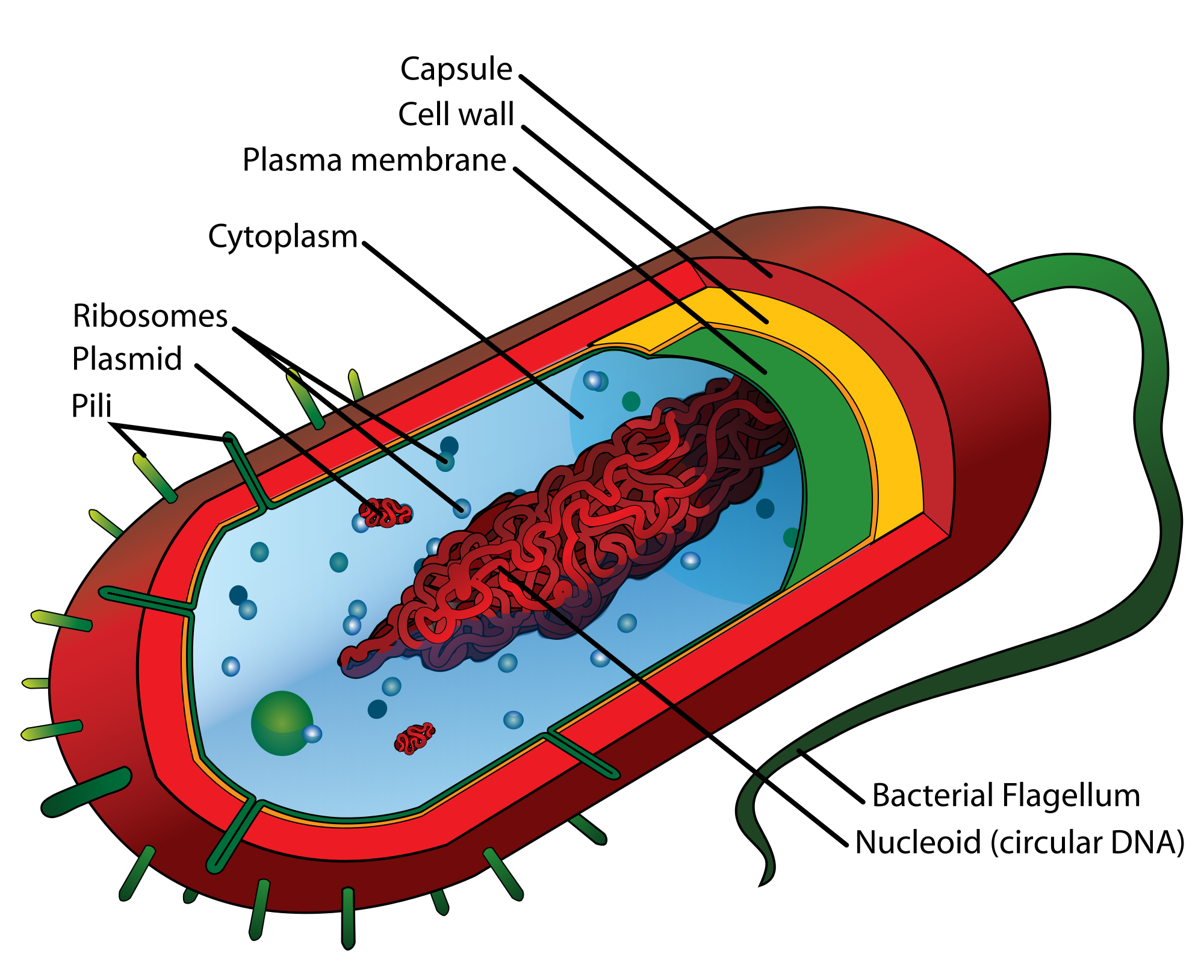
Prokaryotic cells are cells without a nucleus. The DNA in prokaryotic cells is in the cytoplasm, rather than enclosed within a nuclear membrane. In addition, these cells are typically smaller than eukaryotic cells and contain fewer organelles. Prokaryotic cells are found in single-celled organisms, such as the bacterium represented by the model in Figure 4.3.3. Organisms with prokaryotic cells are called prokaryotes. They were the first type of organisms to evolve, and they are still the most common organisms today.
Eukaryotic Cells
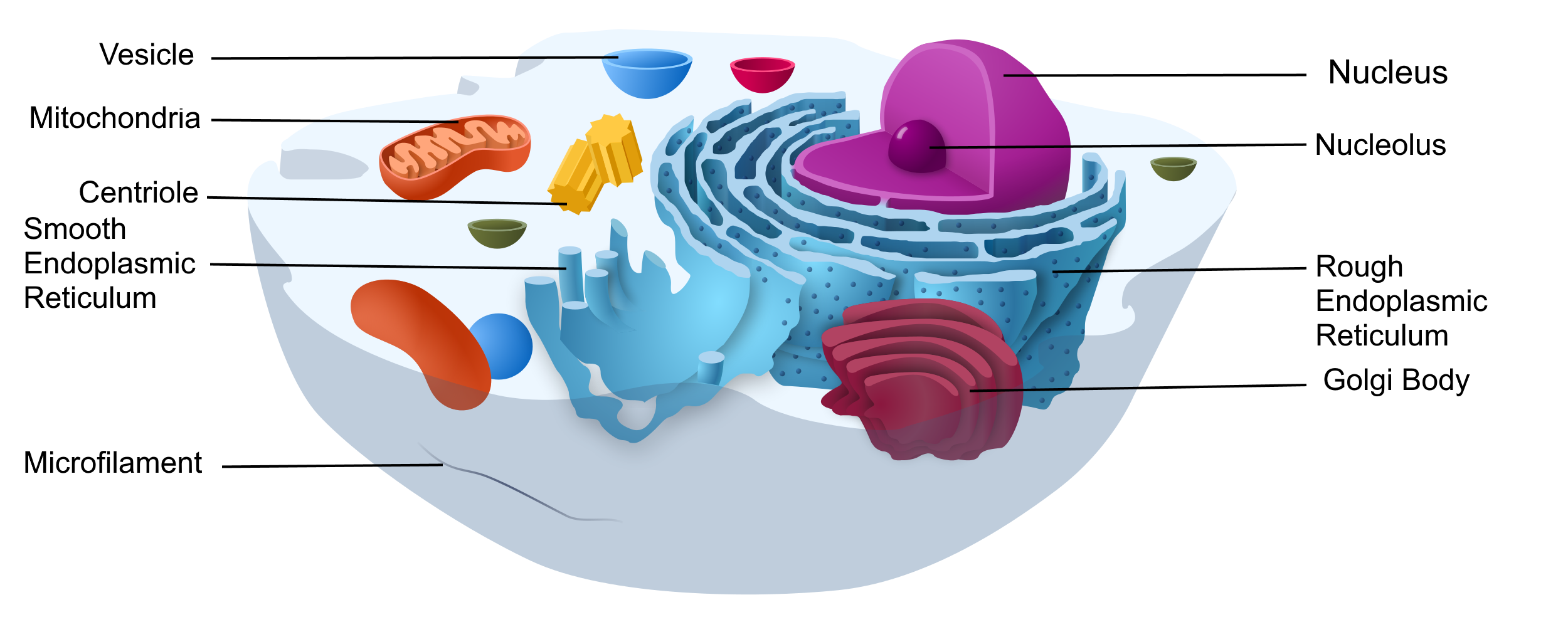
Eukaryotic cells are cells that contain a nucleus. A typical eukaryotic cell is represented by the model in Figure 4.3.4. Eukaryotic cells are usually larger than prokaryotic cells. They are found in some single-celled and all multicellular organisms. Organisms with eukaryotic cells are called eukaryotes, and they range from fungi to humans.
Besides a nucleus, eukaryotic cells also contain other organelles. An organelle is a structure within the cytoplasm that performs a specific job in the cell. Organelles called mitochondria, for example, provide energy to the cell, and organelles called vesicles store substances in the cell. Organelles allow eukaryotic cells to carry out more functions than prokaryotic cells can.
Interestingly, scientists think that mitochondria were once free-living prokaryotes that infected (or were engulfed by) larger cells. The two organisms developed a symbiotic relationship that was beneficial to both of them, resulting in the smaller prokaryote becoming an organelle within the larger cell. This is called endosymbiotic theory, and it is supported by a lot of evidence, including the fact that mitochondria have their own DNA separate from the DNA in the nucleus of the eukaryotic cell. Endosymbiotic theory will be described in more detail in later sections, and it's also discussed in the video below.
https://www.youtube.com/watch?v=FGnS-Xk0ZqU
Endosymbiotic Theory, Amoeba Sisters, 2017.
4.3 Summary
- Cells must be very small so they have a large enough surface area-to-volume ratio to maintain normal cell processes.
- Cells with different functions often have different shapes.
- Prokaryotic cells do not have a nucleus. Eukaryotic cells do have a nucleus, along with other organelles.
4.3 Review Questions
- Explain why most cells are very small.
- Discuss variations in the form and function of cells.
-
-
- Do human cells have organelles? Explain your answer.
- Which are usually larger – prokaryotic or eukaryotic cells? What do you think this means for their relative ability to take in needed substances and release wastes? Discuss your answer.
- DNA in eukaryotes is enclosed within the _______ ________.
- Name three different types of cells in humans.
- Which organelle provides energy in eukaryotic cells?
- What is a function of a vesicle in a cell?
4.3 Explore More
https://www.youtube.com/watch?time_continue=1&v=9i7kAt97XYU&feature=emb_logo
How we think complex cells evolved - Adam Jacobson, TED-Ed, 2015.
https://www.youtube.com/watch?v=Pxujitlv8wc
Prokaryotic vs. Eukaryotic Cells (updated), Amoeba Sisters, 2018.
Attributions
Figure 4.3.1
Borrelia_hermsii_Bacteria_(13758011613) by NAID on Wikimedia Commons is released into the public domain (https://en.wikipedia.org/wiki/Public_domain).
Figure 4.3.2
Cell Size by Christine Miller is released into the Public Domain (https://creativecommons.org/publicdomain/mark/1.0/).
Figure 4.3.3
- Chondrocyte. BioTek-Wikipedia-Image by BioTek Instruments, Inc. on Wikimedia Commons is used under a CC BY-SA 3.0 (https://creativecommons.org/licenses/by-sa/3.0/deed.en) license.
- Neutrophil with anthrax copy by Volker Brinkmann from PLOS Pathogens on Wikimedia Commons is used under a CC BY 2.5 (https://creativecommons.org/licenses/by/2.5/deed.en) license.
- PLoSBiol4.e126.Fig6fNeuron by Lee, et al. from PLOS Biology on Wikimedia Commons is used under a CC BY 2.5 (https://creativecommons.org/licenses/by/2.5/deed.en) license.
- Sperm (265 33) human by Doc. RNDr. Josef Reischig, CSc. on Wikimedia Commons is used under a CC BY-SA 3.0 (https://creativecommons.org/licenses/by-sa/3.0) license.
Figure 4.3.4
Model of a prokaryotic cell: bacterium by Mariana Ruiz Villarreal [LadyofHats] on Wikimedia Commons is released into the public domain (https://en.wikipedia.org/wiki/Public_domain).
Figure 4.3.5
Animal Cell adapted by Christine Miller is used under a CC0 1.0 (https://creativecommons.org/publicdomain/zero/1.0/deed.en) public domain dedication license. (Original image, Animal Cell Unannotated, is by Kelvin Song on Wikimedia Commons.)
References
Amoeba Sisters. (2017, May 3). Endosymbiotic theory. YouTube. https://www.youtube.com/watch?v=FGnS-Xk0ZqU&feature=youtu.be
Amoeba Sisters. (2018, July 30). Prokaryotic vs. eukaryotic cells (updated). YouTube. https://www.youtube.com/watch?v=Pxujitlv8wc&feature=youtu.be
Brinkmann, V. (November 2005). Neutrophil engulfing Bacillus anthracis. PLoS Pathogens 1 (3): Cover page [digital image]. DOI:10.1371. https://journals.plos.org/plospathogens/issue?id=10.1371/issue.ppat.v01.i03
Lee, W.C.A., Huang, H., Feng, G., Sanes, J.R., Brown, E.N., et al. (2005, December 27) Figure 6f, slightly altered (plus scalebar, minus letter "f".) [digital image]. Dynamic Remodeling of Dendritic Arbors in GABAergic Interneurons of Adult Visual Cortex. PLoS Biology, 4(2), e29. doi:10.1371/journal.pbio.0040029. https://journals.plos.org/plosbiology/article?id=10.1371/journal.pbio.0040029
TED-Ed. (2015, February 17). How we think complex cells evolved - Adam Jacobson. https://www.youtube.com/watch?v=9i7kAt97XYU&feature=youtu.be

